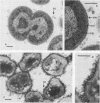Abstract
Branhamella catarrhalis was formerly regarded as a common, essentially harmless inhabitant of the pharynx. This misapprehension was caused, in part, by confusion with another pharyngeal resident, Neisseria cinerea. The two organisms can now be differentiated by the positive reactions of B. catarrhalis in tests for nitrate reduction and hydrolysis of tributyrin and DNase. B. catarrhalis is currently recognized as the third most frequent cause of acute otitis media and acute sinusitis in young children. It often causes acute exacerbations of chronic bronchopulmonary disease in older or immunocompromised adults and is incriminated occasionally in meningitis, endocarditis, bacteremia, conjunctivitis, keratitis, and urogenital infections. Virulence-associated factors, such as pili, capsules, outer membrane vesicles, iron acquisition proteins, histamine-synthesizing ability, resistance to the bactericidal action of normal human serum, and binding to the C1q complement component, have been identified in some strains. beta-Lactamase producing strains, first detected in 1976, have risen to approximately 75% worldwide. Thus far, however, practically all American strains of B. catarrhalis remain susceptible to alternative antibiotics. A possible selective advantage of recent isolates is their reportedly heightened tendency for adherence to oropharyngeal cells from patients with chronic bronchopulmonary disease.
Full text
PDF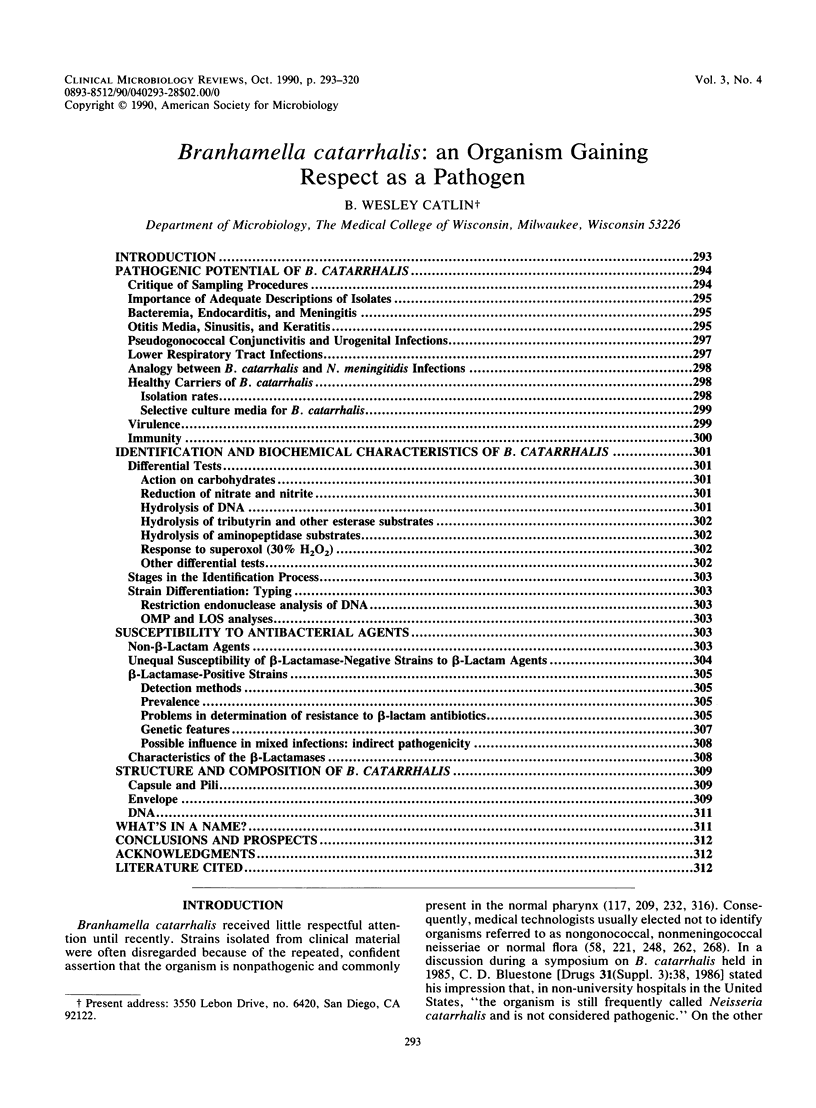
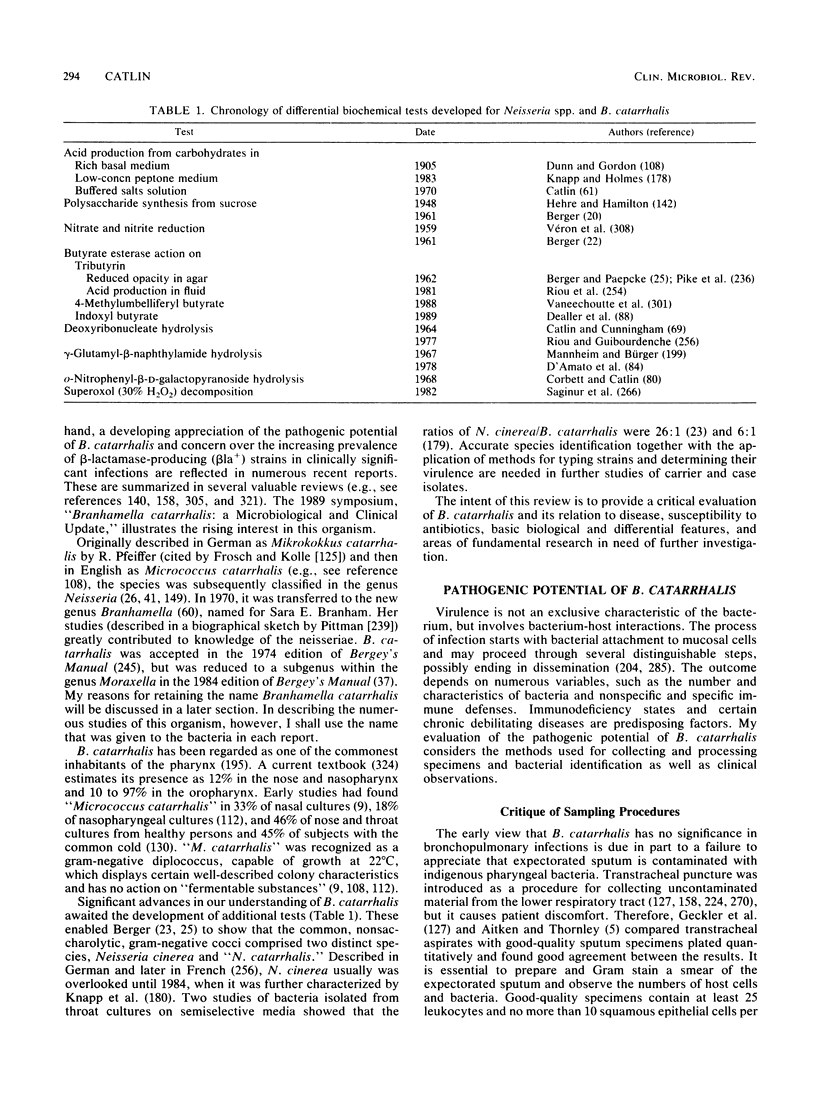
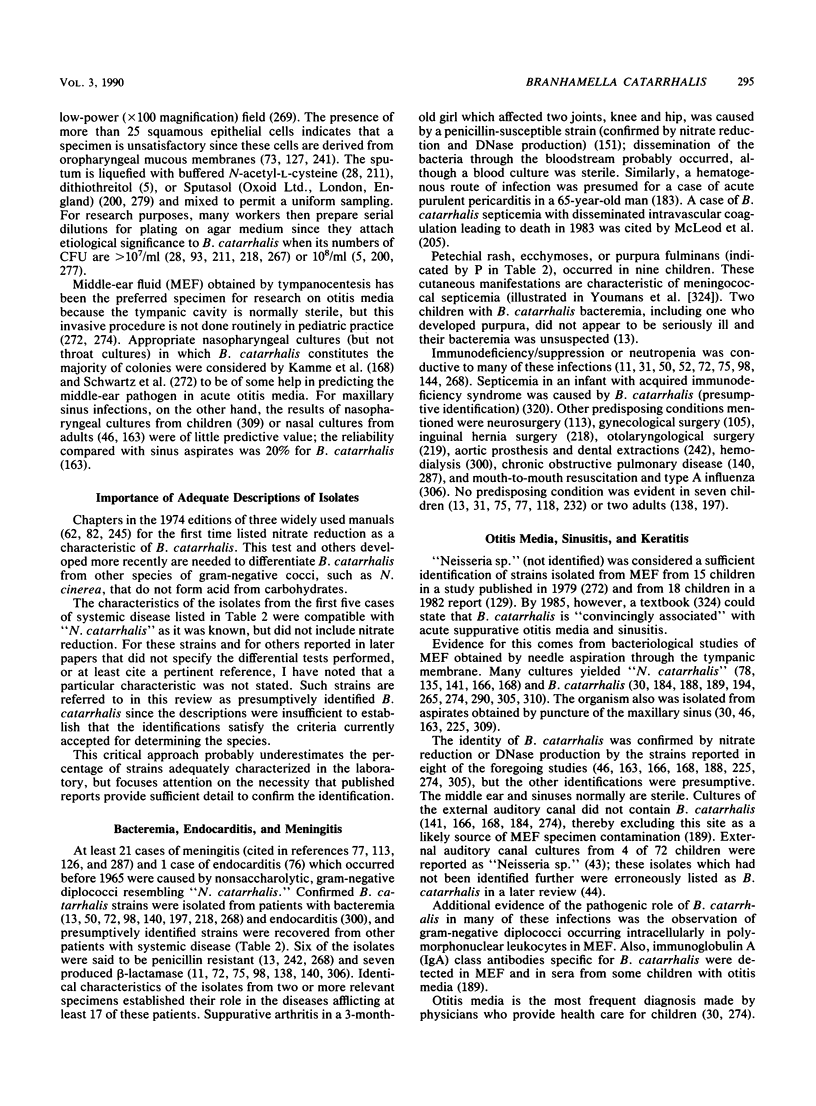
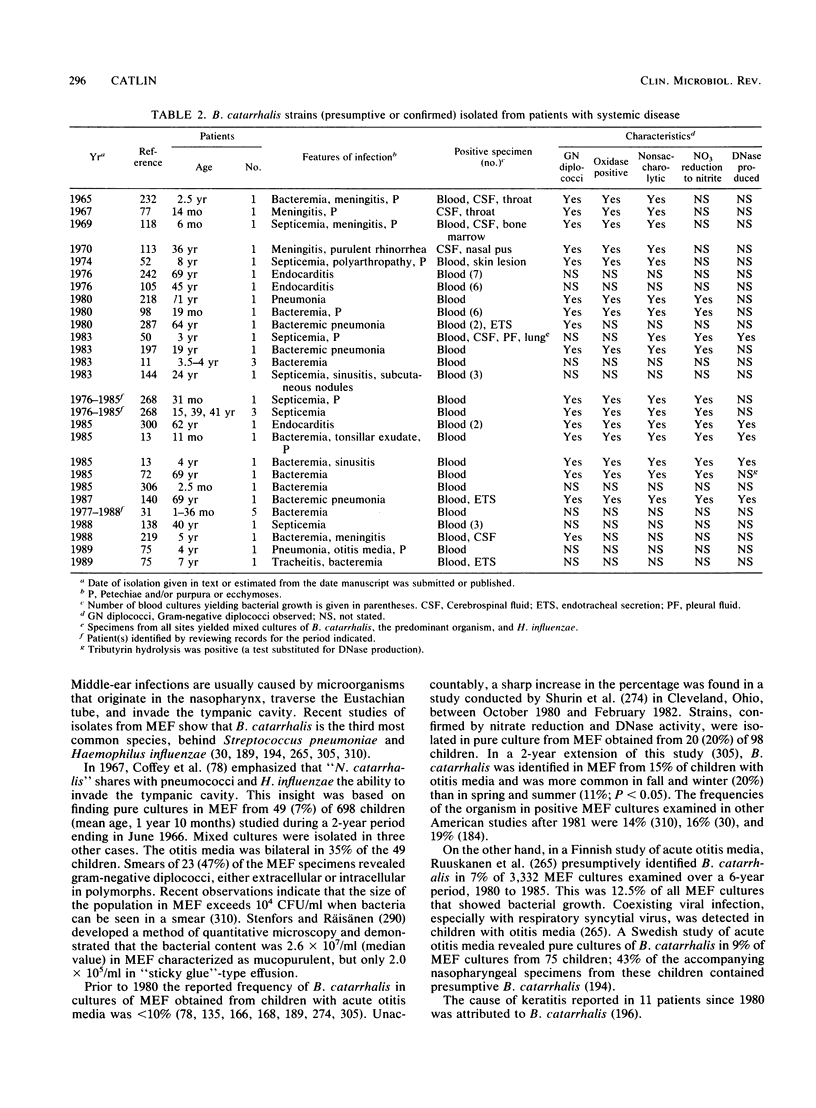
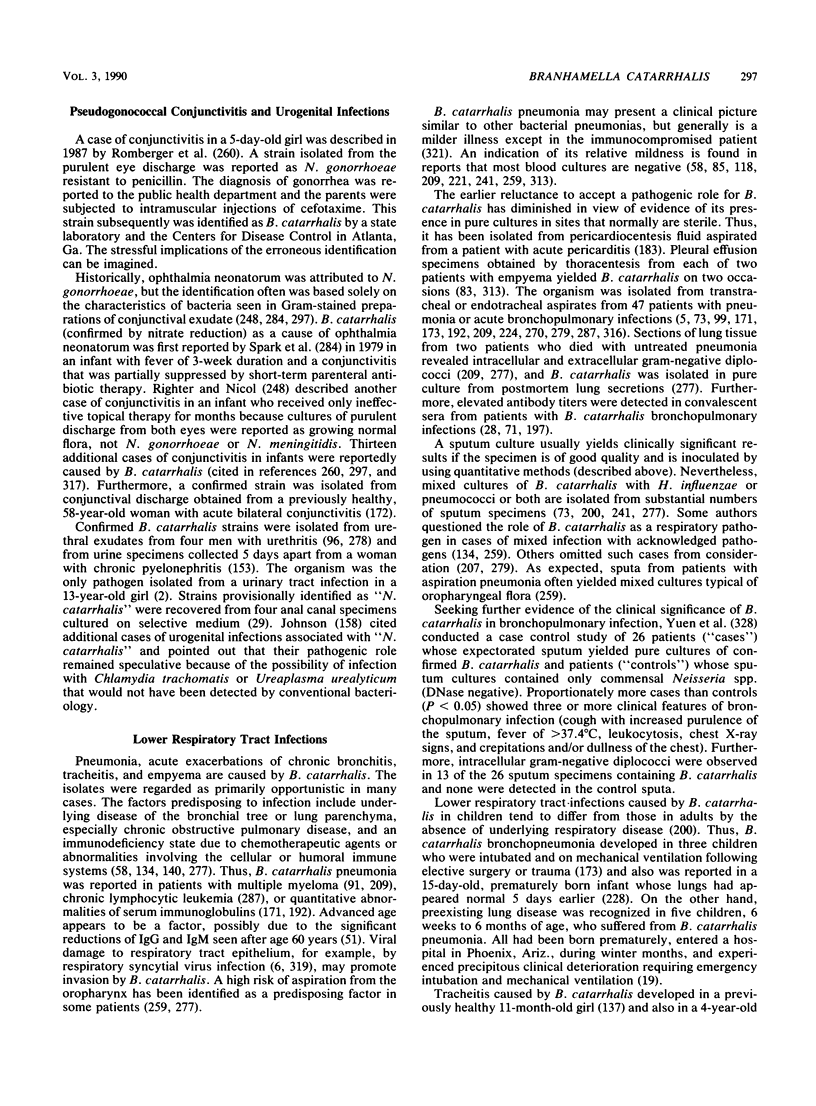

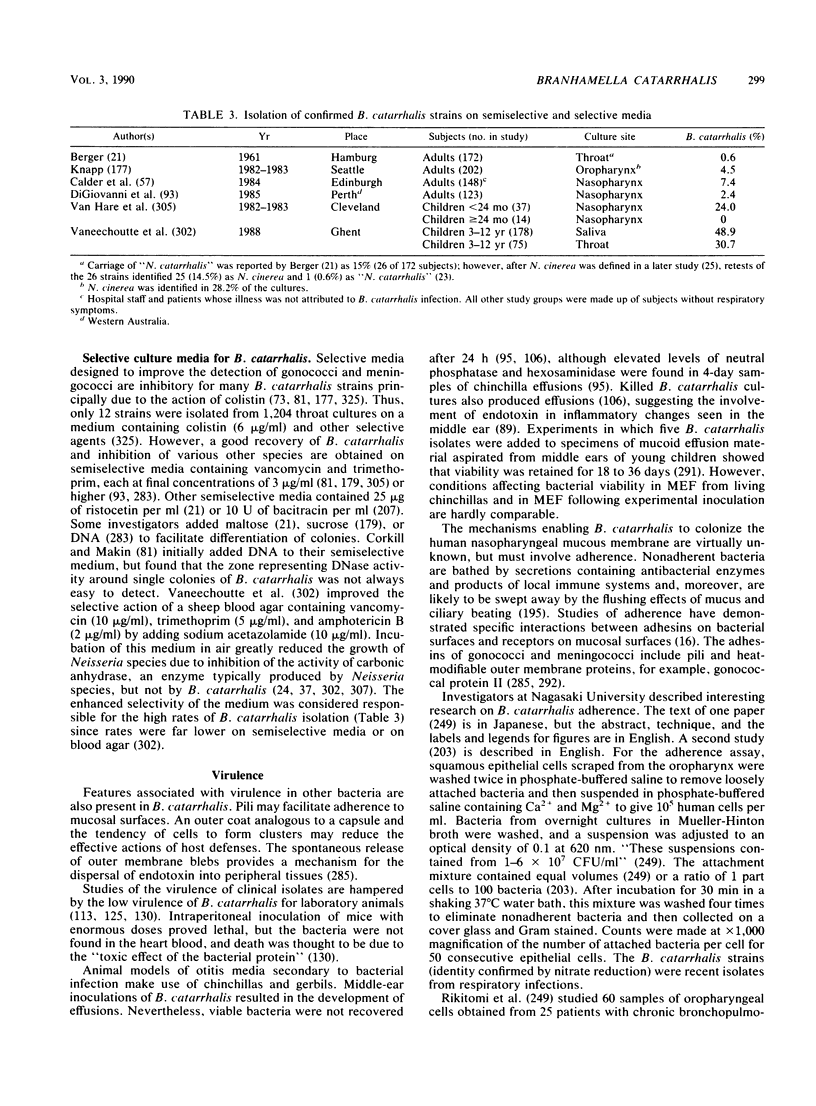

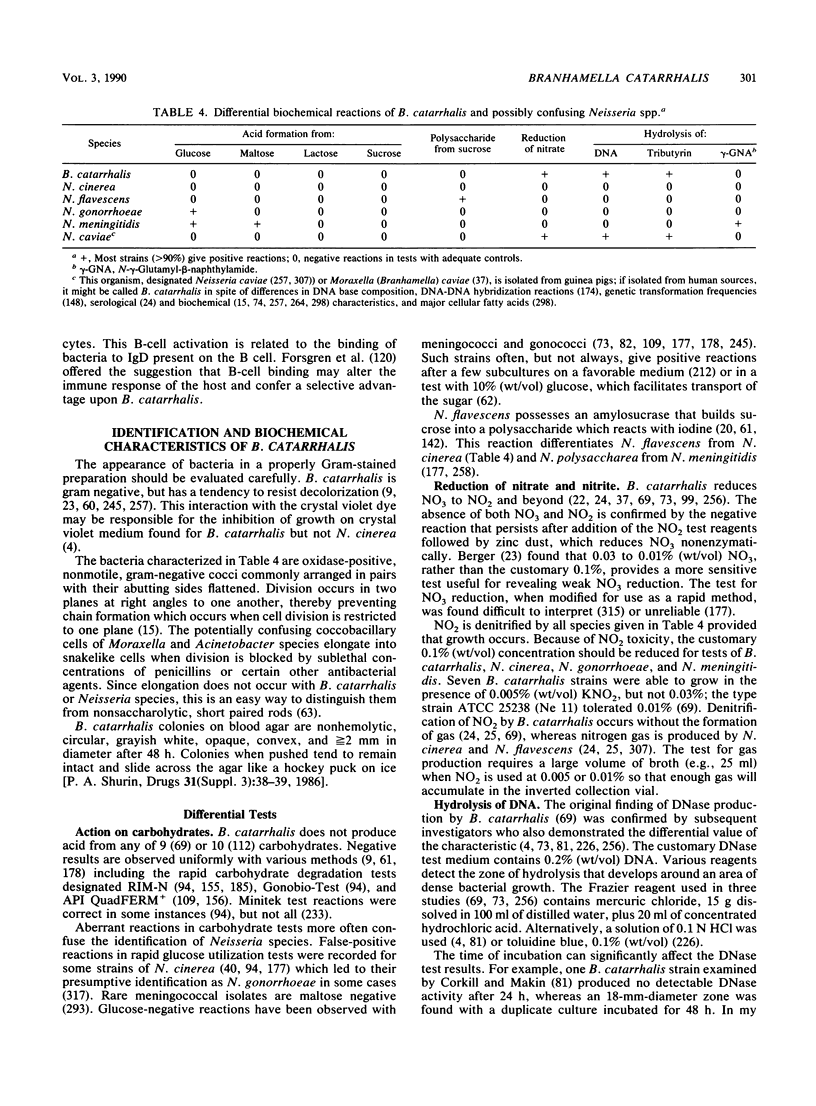
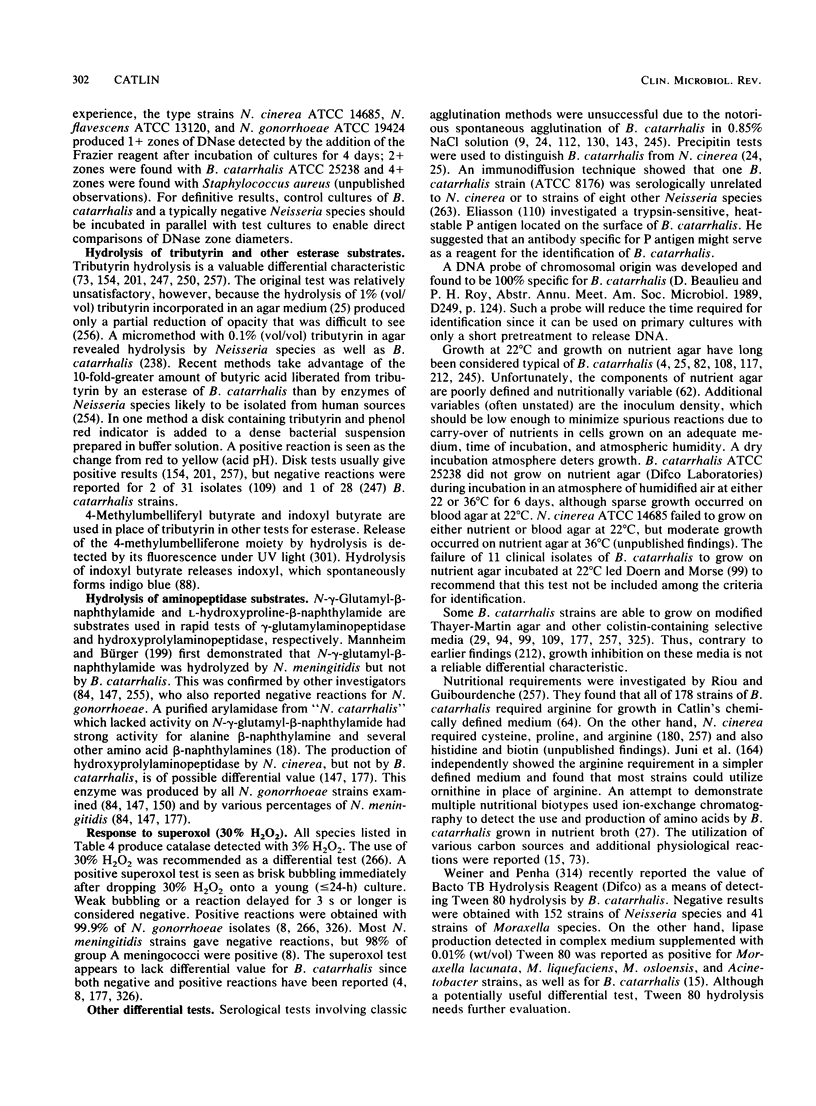
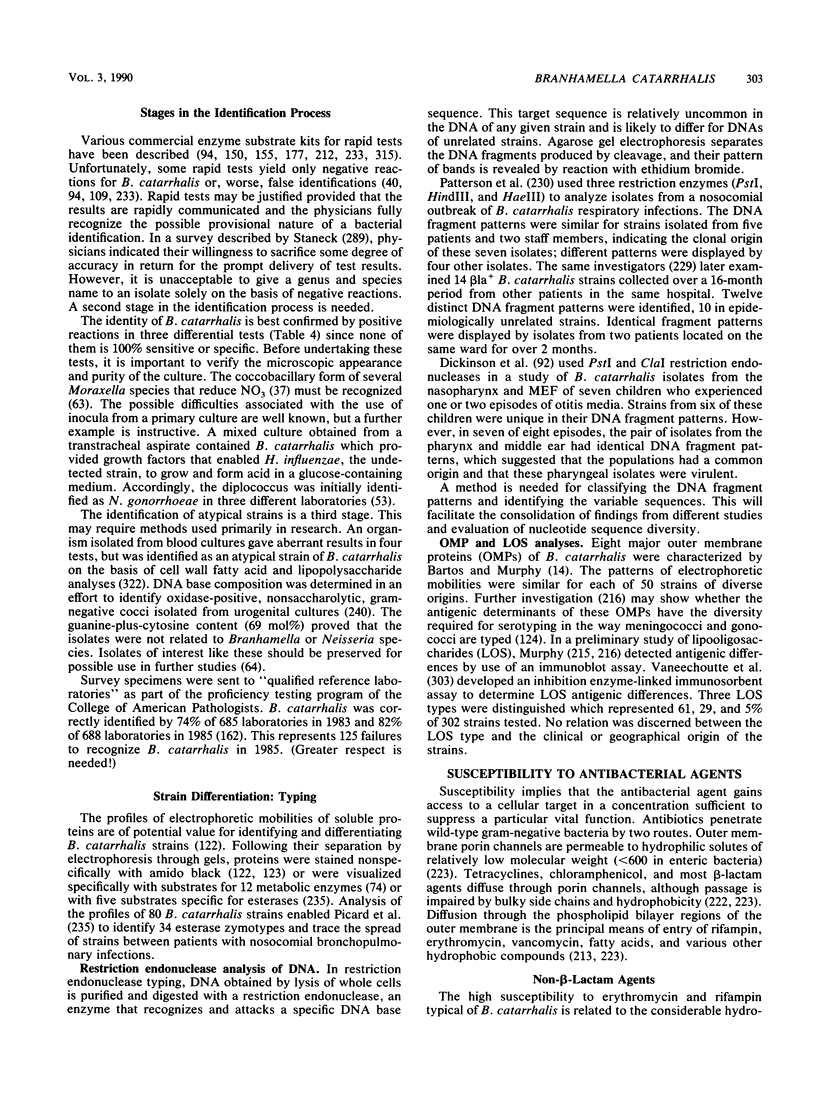
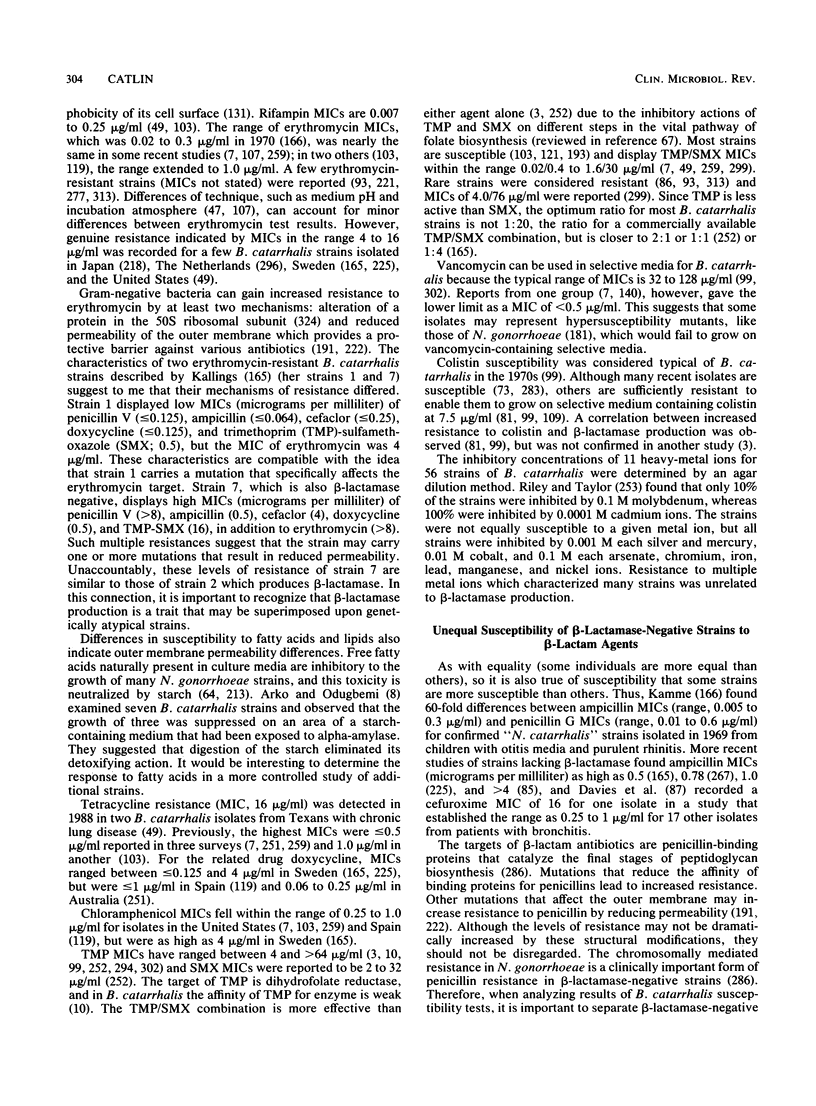
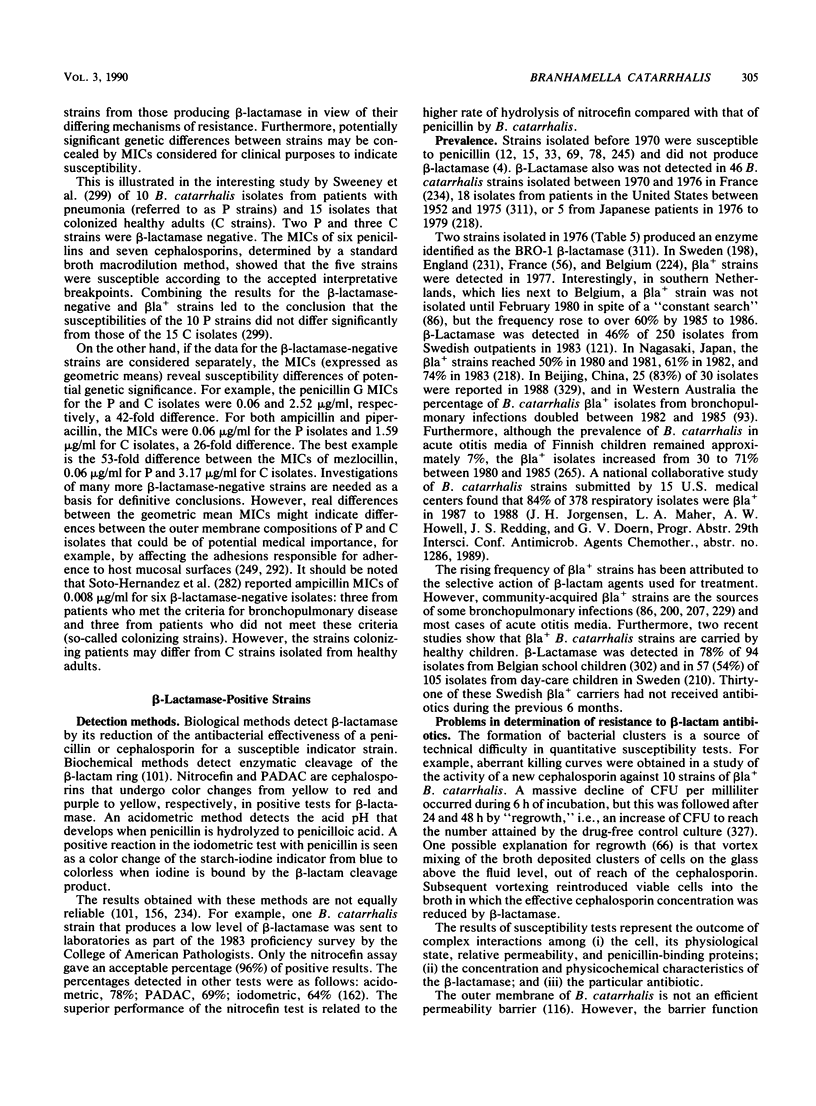

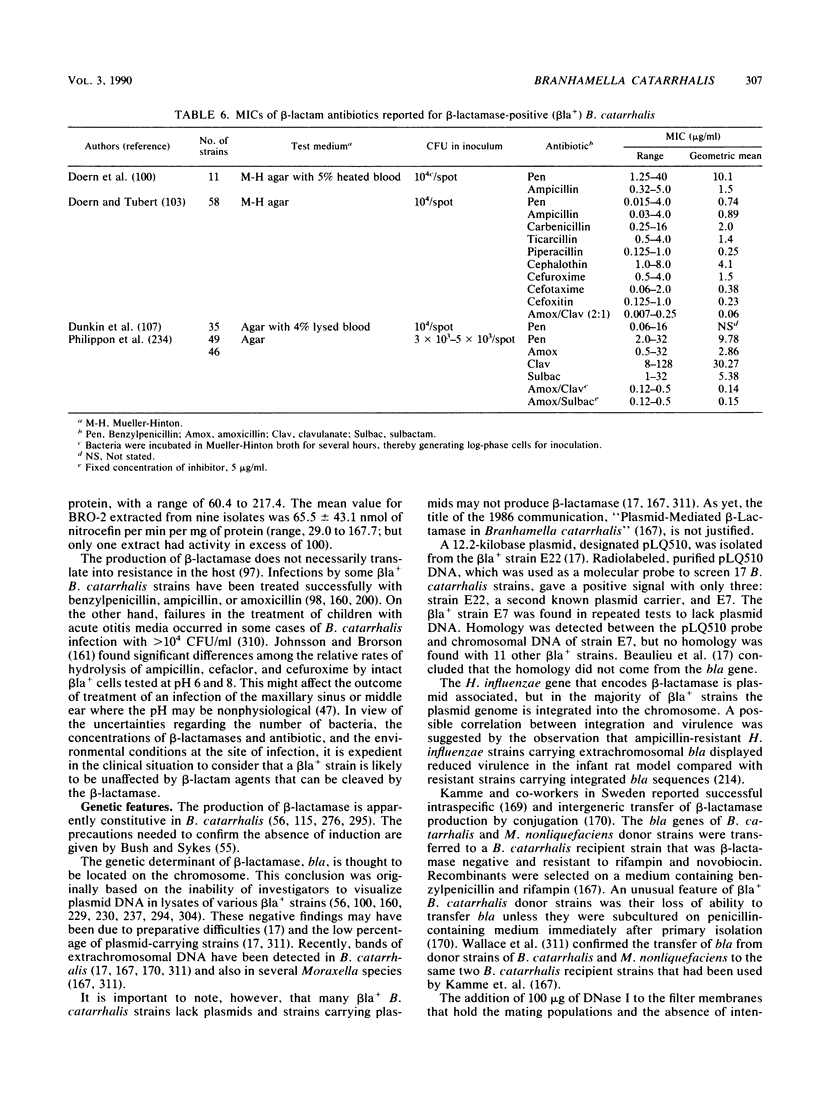

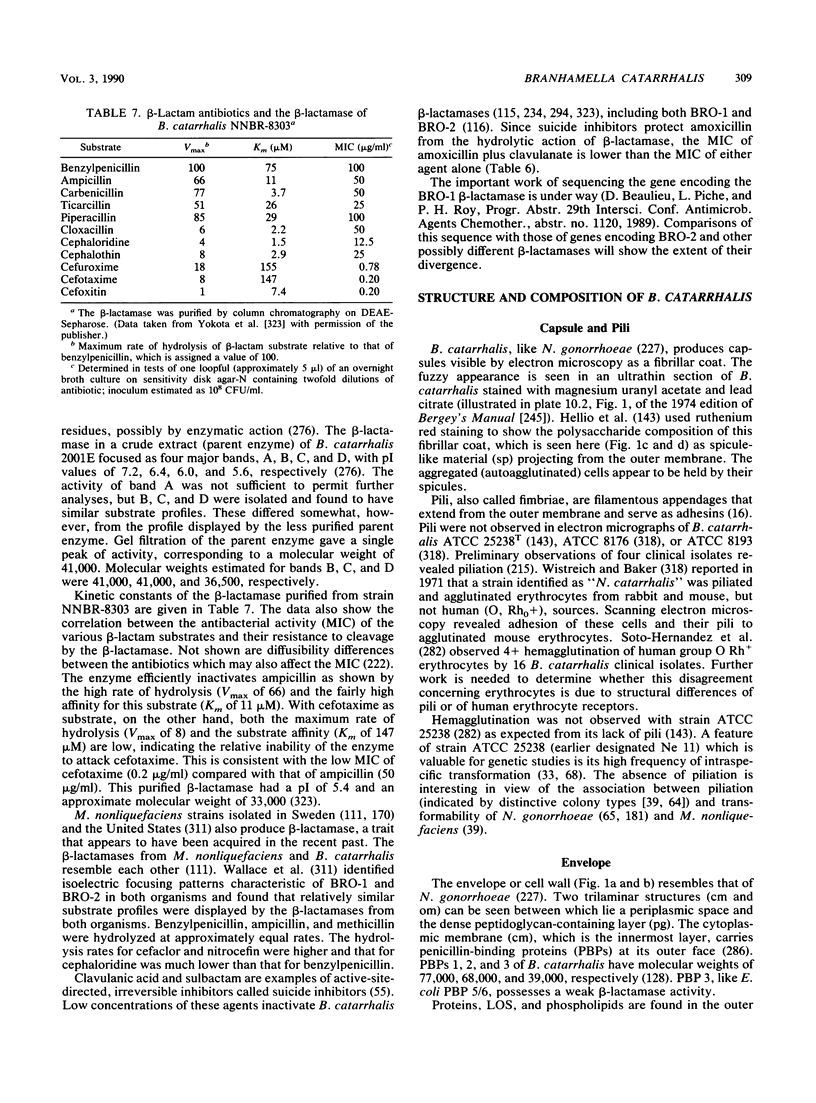
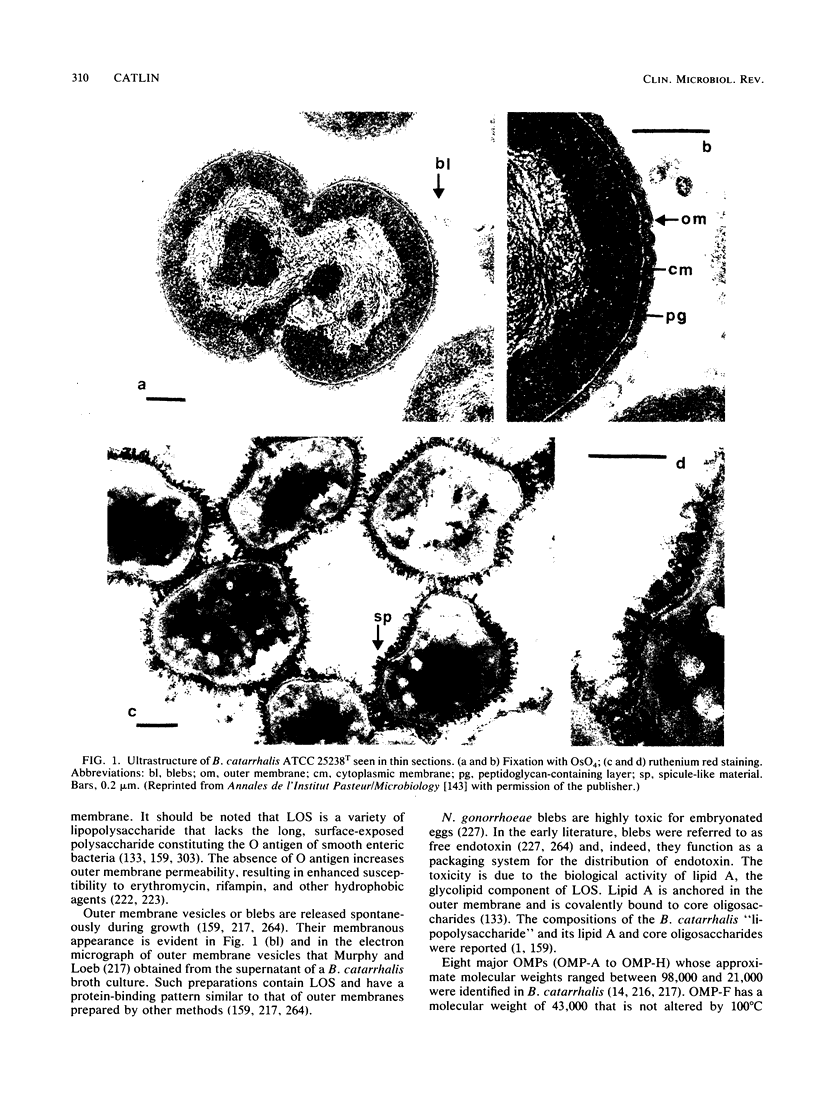
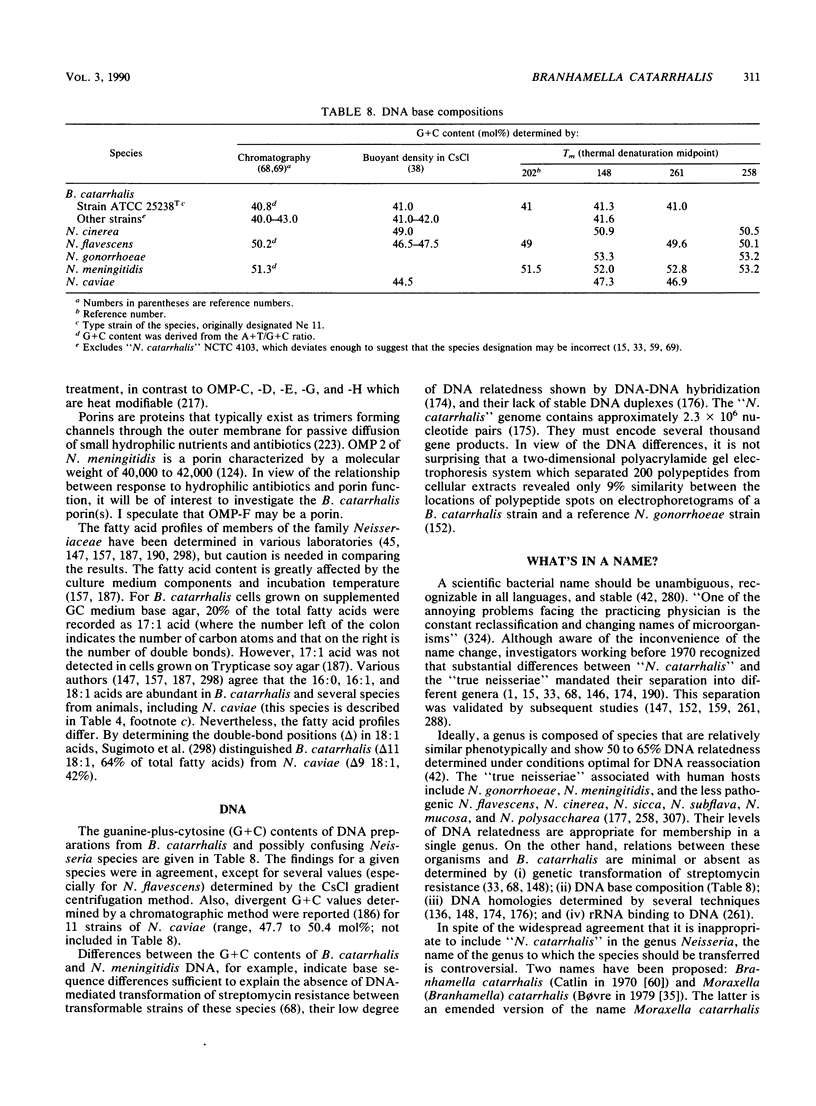


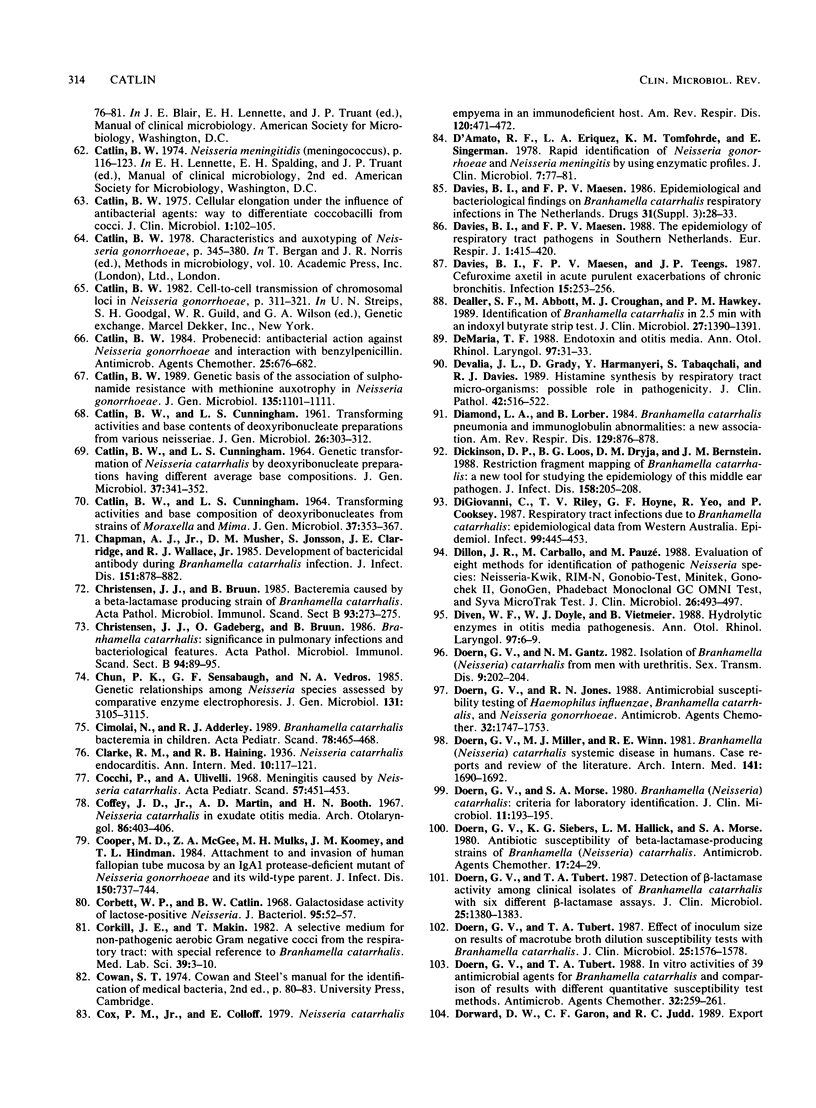
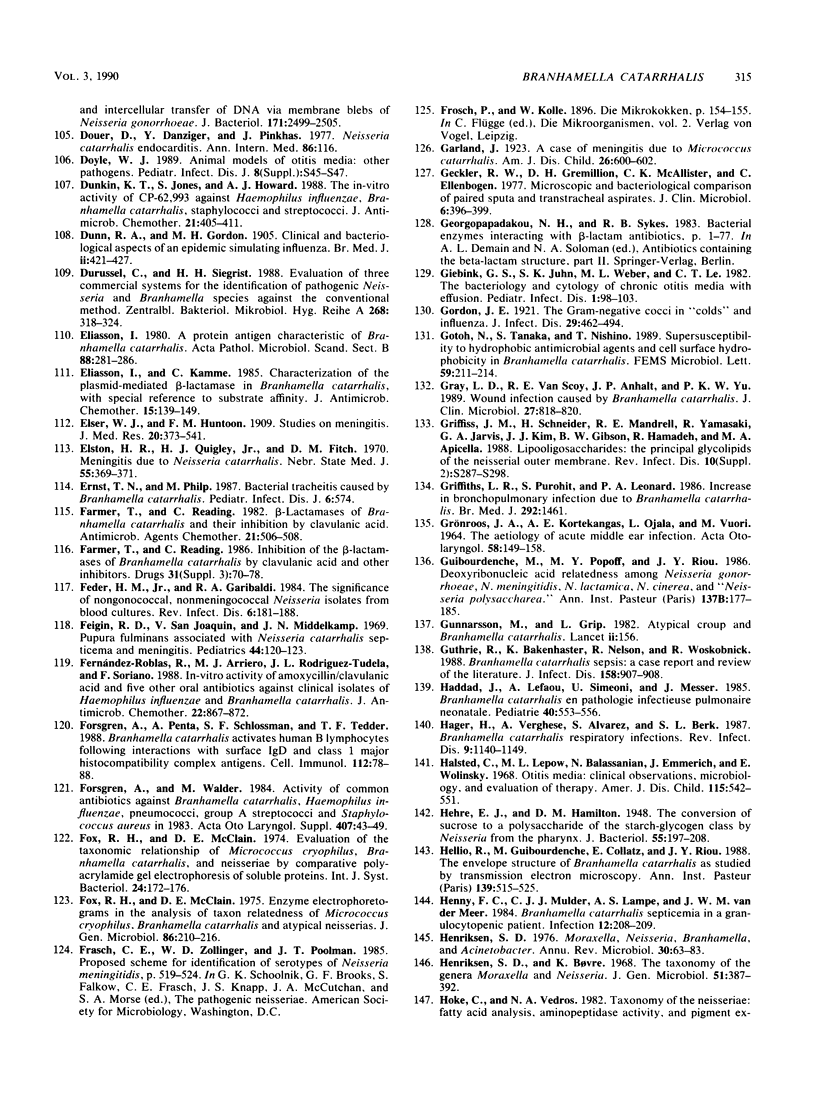
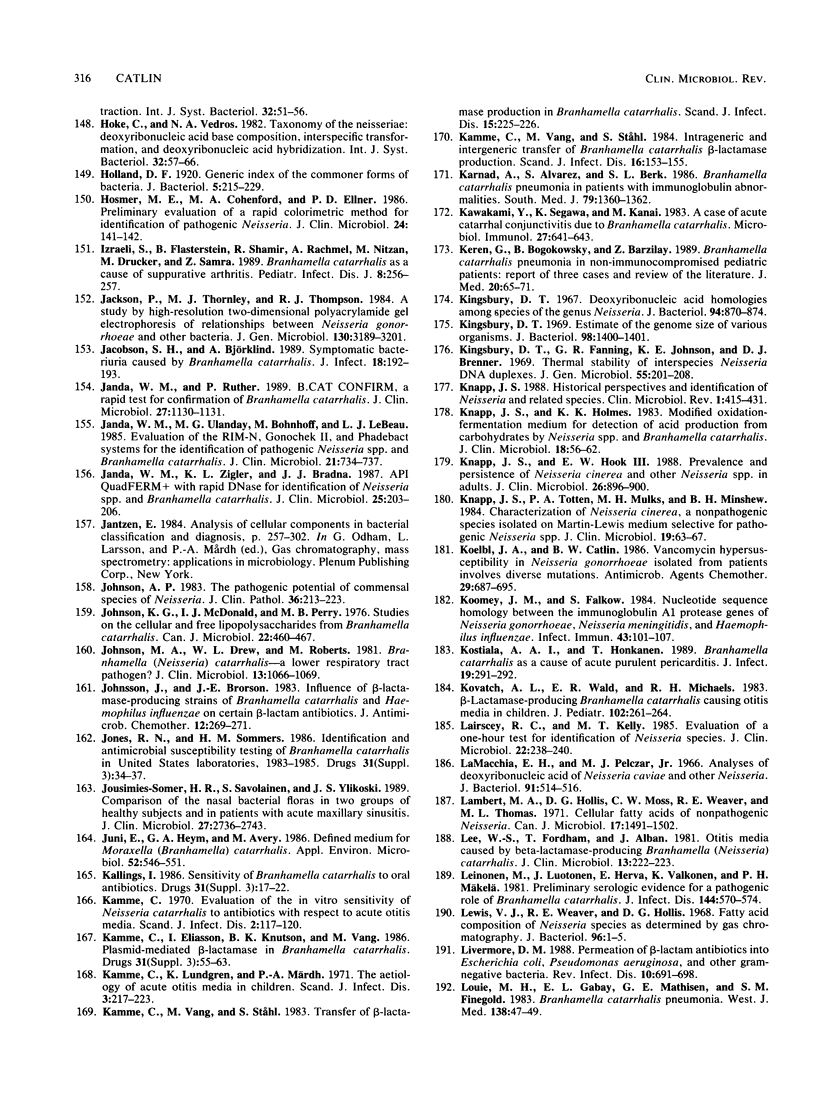
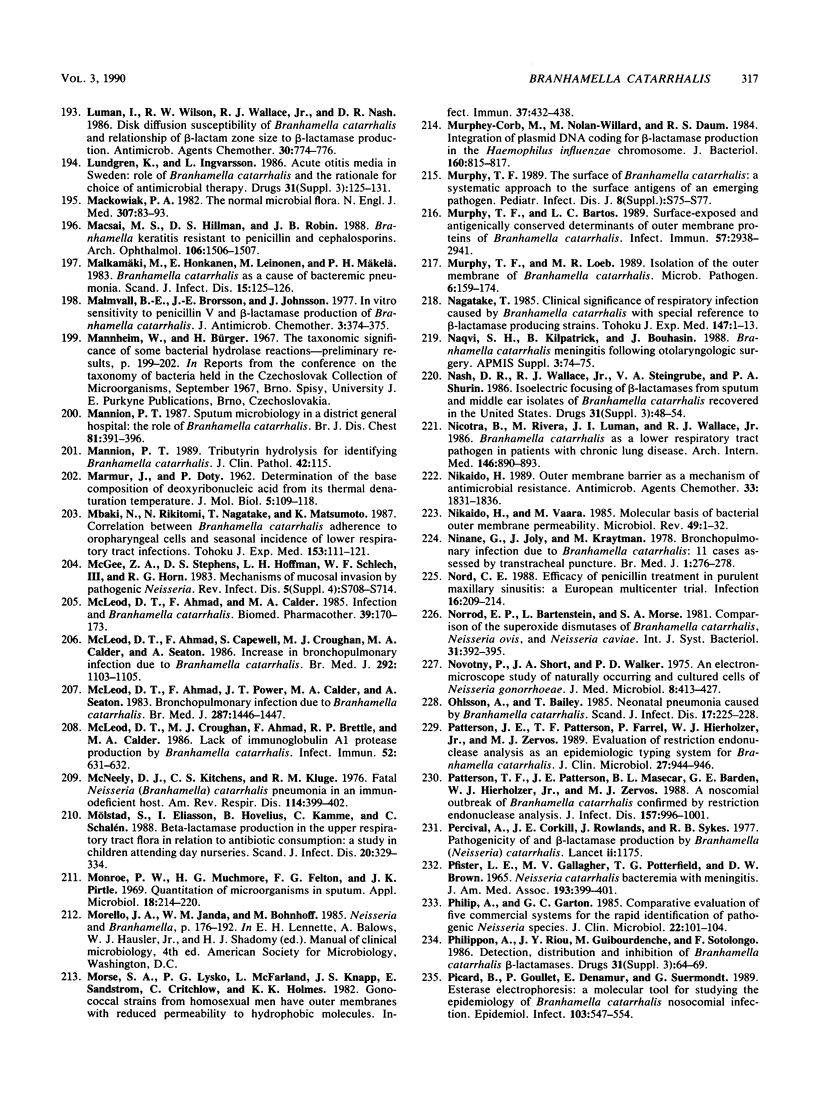
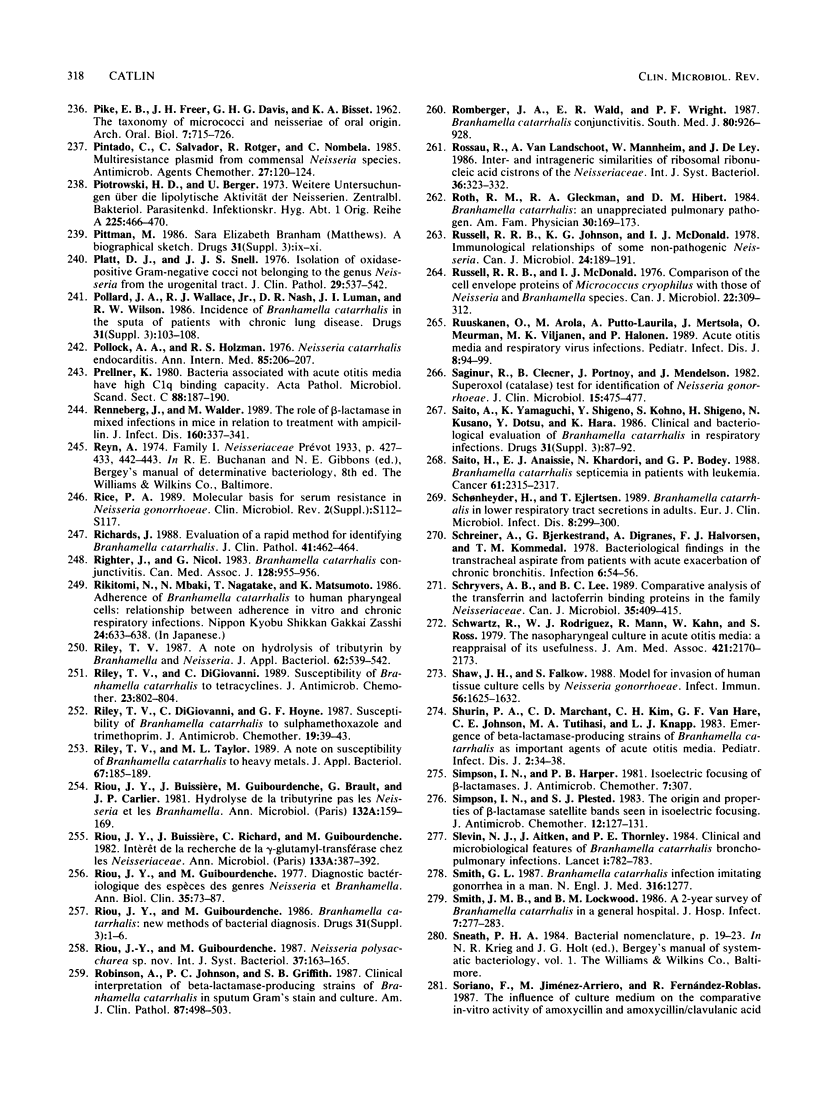
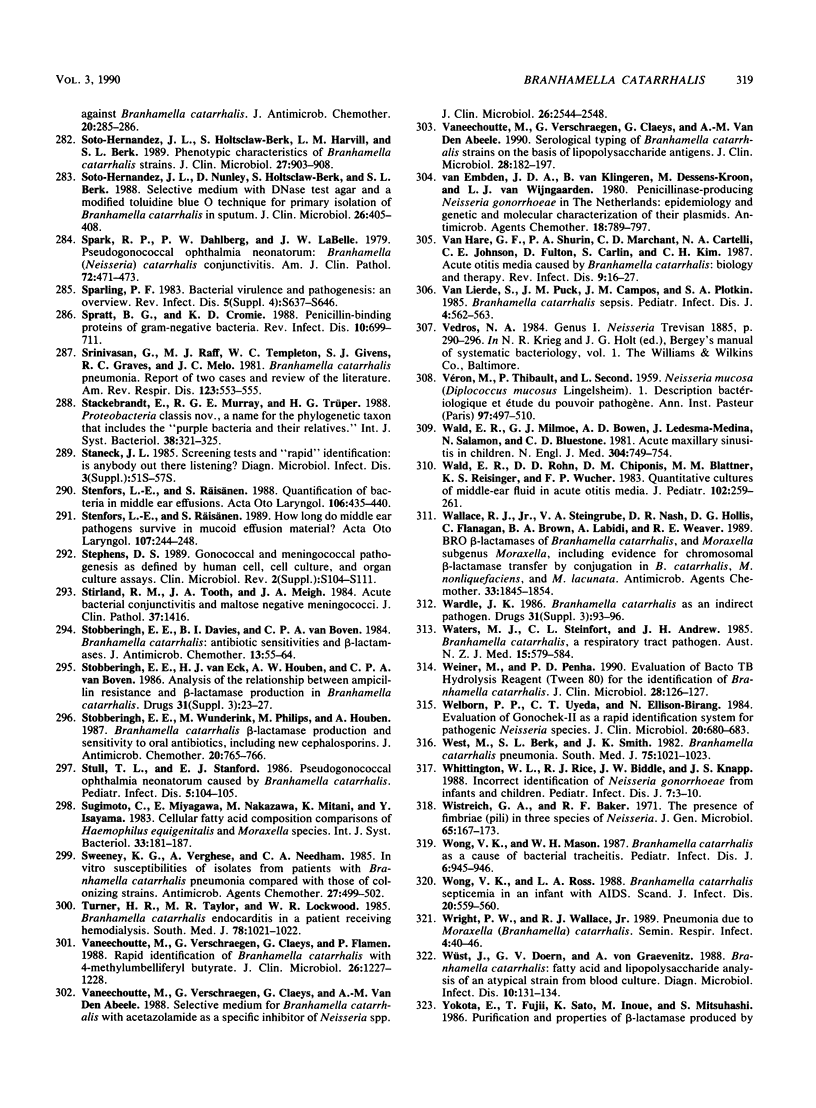

Images in this article
Selected References
These references are in PubMed. This may not be the complete list of references from this article.
- Adams G. A., Tornabene T. G., Yaguchi M. Cell wall lipopolysaccharides from Neisseria catarrhalis. Can J Microbiol. 1969 Apr;15(4):365–374. doi: 10.1139/m69-067. [DOI] [PubMed] [Google Scholar]
- Ahmad F., Calder M. A., Croughan M. J., Marshall T. G. Urinary tract infection caused by Branhamella catarrhalis. J Infect. 1985 Mar;10(2):176–177. doi: 10.1016/s0163-4453(85)91711-6. [DOI] [PubMed] [Google Scholar]
- Ahmad F., McLeod D. T., Croughan M. J., Calder M. A. Antimicrobial susceptibility of Branhamella catarrhalis isolates from bronchopulmonary infections. Antimicrob Agents Chemother. 1984 Sep;26(3):424–425. doi: 10.1128/aac.26.3.424. [DOI] [PMC free article] [PubMed] [Google Scholar]
- Ahmad F., Young H., McLeod D. T., Croughan M. J., Calder M. A. Characterisation of Branhamella catarrhalis and differentiation from Neisseria species in a diagnostic laboratory. J Clin Pathol. 1987 Nov;40(11):1369–1373. doi: 10.1136/jcp.40.11.1369. [DOI] [PMC free article] [PubMed] [Google Scholar]
- Aitken J. M., Thornley P. E. Isolation of Branhamella catarrhalis from sputum and tracheal aspirate. J Clin Microbiol. 1983 Nov;18(5):1262–1263. doi: 10.1128/jcm.18.5.1262-1263.1983. [DOI] [PMC free article] [PubMed] [Google Scholar]
- Alligood G. A., Kenny J. F. Tracheitis and supraglottis associated with Branhamella catarrhalis and respiratory syncytial virus. Pediatr Infect Dis J. 1989 Mar;8(3):190–191. [PubMed] [Google Scholar]
- Alvarez S., Jones M., Holtsclaw-Berk S., Guarderas J., Berk S. L. In vitro susceptibilities and beta-lactamase production of 53 clinical isolates of Branhamella catarrhalis. Antimicrob Agents Chemother. 1985 Apr;27(4):646–647. doi: 10.1128/aac.27.4.646. [DOI] [PMC free article] [PubMed] [Google Scholar]
- Arko R. J., Odugbemi T. Superoxol and amylase inhibition tests for distinguishing gonococcal and nongonococcal cultures growing on selective media. J Clin Microbiol. 1984 Jul;20(1):1–4. doi: 10.1128/jcm.20.1.1-4.1984. [DOI] [PMC free article] [PubMed] [Google Scholar]
- Averett D. R., Roth B., Burchall J. J., Baccanari D. P. Dihydrofolate reductase from Neisseria sp. Antimicrob Agents Chemother. 1979 Mar;15(3):428–435. doi: 10.1128/aac.15.3.428. [DOI] [PMC free article] [PubMed] [Google Scholar]
- BARBER M., WATERWORTH P. M. Antibacterial activity of the penicillins. Br Med J. 1962 Apr 28;1(5286):1159–1164. doi: 10.1136/bmj.1.5286.1159. [DOI] [PMC free article] [PubMed] [Google Scholar]
- BERGER U., PAEPCKE E. [Studies on asaccharolytic Neisseria in the human nasopharynx]. Z Hyg Infektionskr. 1962;148:269–281. [PubMed] [Google Scholar]
- Bannatyne R. M., Kolodej V. Branhamella catarrhalis bacteraemia and immunosuppression--part of a larger problem? Diagn Microbiol Infect Dis. 1985 Jan;3(1):65–67. doi: 10.1016/0732-8893(85)90068-9. [DOI] [PubMed] [Google Scholar]
- Baron J., Shapiro E. D. Unsuspected bacteremia caused by Branhamella catarrhalis. Pediatr Infect Dis. 1985 Jan-Feb;4(1):100–101. doi: 10.1097/00006454-198501000-00025. [DOI] [PubMed] [Google Scholar]
- Bartos L. C., Murphy T. F. Comparison of the outer membrane proteins of 50 strains of Branhamella catarrhalis. J Infect Dis. 1988 Oct;158(4):761–765. doi: 10.1093/infdis/158.4.761. [DOI] [PubMed] [Google Scholar]
- Baumann P., Doudoroff M., Stanier R. Y. Study of the Moraxella group. I. Genus Moraxella and the Neisseria catarrhalis group. J Bacteriol. 1968 Jan;95(1):58–73. doi: 10.1128/jb.95.1.58-73.1968. [DOI] [PMC free article] [PubMed] [Google Scholar]
- Beachey E. H. Bacterial adherence: adhesin-receptor interactions mediating the attachment of bacteria to mucosal surface. J Infect Dis. 1981 Mar;143(3):325–345. doi: 10.1093/infdis/143.3.325. [DOI] [PubMed] [Google Scholar]
- Beaulieu D., Ouellette M., Bergeron M. G., Roy P. H. Characterization of a plasmid isolated from Branhamella catarrhalis and detection of plasmid sequences within the genome of a B. catarrhalis strain. Plasmid. 1988 Sep;20(2):158–162. doi: 10.1016/0147-619x(88)90020-0. [DOI] [PubMed] [Google Scholar]
- Behal F. J., Folds J. D. Arylamidase of Neisseria catarrhalis. Arch Biochem Biophys. 1967 Aug;121(2):364–371. doi: 10.1016/0003-9861(67)90089-6. [DOI] [PubMed] [Google Scholar]
- Berg R. A., Bartley D. L. Pneumonia associated with Branhamella catarrhalis in infants. Pediatr Infect Dis J. 1987 Jun;6(6):569–573. doi: 10.1097/00006454-198706000-00017. [DOI] [PubMed] [Google Scholar]
- Bezjak V., Shah H. N., Barley J. Profiles of amino-acid utilisation and production amongst strains of Branhamella catarrhalis. J Med Microbiol. 1988 Jun;26(2):143–146. doi: 10.1099/00222615-26-2-143. [DOI] [PubMed] [Google Scholar]
- Black A. J., Wilson T. S. Immunoglobulin G (IgG) serological response to Branhamella catarrhalis in patients with acute bronchopulmonary infections. J Clin Pathol. 1988 Mar;41(3):329–333. doi: 10.1136/jcp.41.3.329. [DOI] [PMC free article] [PubMed] [Google Scholar]
- Blackwell C., Young H., Bain S. S. Isolation of Neisseria meningitidis and Neisseria catarrhalis from the genitourinary tract and anal canal. Br J Vener Dis. 1978 Feb;54(1):41–44. doi: 10.1136/sti.54.1.41. [DOI] [PMC free article] [PubMed] [Google Scholar]
- Bluestone C. D. Otitis media and sinusitis in children. Role of Branhamella catarrhalis. Drugs. 1986;31 (Suppl 3):132–141. doi: 10.2165/00003495-198600313-00029. [DOI] [PubMed] [Google Scholar]
- Bonadio W. A. Branhamella catarrhalis bacteremia in children. Pediatr Infect Dis J. 1988 Oct;7(10):738–739. doi: 10.1097/00006454-198810000-00018. [DOI] [PubMed] [Google Scholar]
- Bovre K., Fiandt M., Szybalski W. DNA base composition of Neisseria, Moraxella, and Acinetobacter, as determined by measurement of buoyant density in CsCl gradients. Can J Microbiol. 1969 Apr;15(4):335–338. doi: 10.1139/m69-062. [DOI] [PubMed] [Google Scholar]
- Boyce J. M., Mitchell E. B., Jr Difficulties in differentiating Neisseria cinerea from Neisseria gonorrhoeae in rapid systems used for identifying pathogenic Neisseria species. J Clin Microbiol. 1985 Nov;22(5):731–734. doi: 10.1128/jcm.22.5.731-734.1985. [DOI] [PMC free article] [PubMed] [Google Scholar]
- Brook I. Direct and indirect pathogenicity of Branhamella catarrhalis. Drugs. 1986;31 (Suppl 3):97–102. doi: 10.2165/00003495-198600313-00021. [DOI] [PubMed] [Google Scholar]
- Brook I. Microbiological studies of the bacterial flora of the external auditory canal in children. Acta Otolaryngol. 1981 Mar-Apr;91(3-4):285–287. doi: 10.3109/00016488109138509. [DOI] [PubMed] [Google Scholar]
- Brooks J. B., Kellogg D. S., Thacker L., Turner E. M. Analysis by gas chromatography of fatty acids found in whole cultural extracts of Neisseria species. Can J Microbiol. 1971 Apr;17(4):531–543. doi: 10.1139/m71-088. [DOI] [PubMed] [Google Scholar]
- Brorson J. E., Axelsson A., Holm S. E. Studies on Branhamella Catarrhalis (Neisseria catarrhalis) with special reference to maxillary sinusitis. Scand J Infect Dis. 1976;8(3):151–155. doi: 10.3109/inf.1976.8.issue-3.05. [DOI] [PubMed] [Google Scholar]
- Brorson J. E., Larsson P. pH and incubation atmosphere influence erythromycin activity against Branhamella catarrhalis. J Antimicrob Chemother. 1985 May;15(5):644–645. doi: 10.1093/jac/15.5.644. [DOI] [PubMed] [Google Scholar]
- Brorson J. E., Malmvall B. E. Branhamella catarrhalis and other bacteria in the nasopharynx of children with longstanding cough. Scand J Infect Dis. 1981;13(2):111–113. doi: 10.3109/inf.1981.13.issue-2.06. [DOI] [PubMed] [Google Scholar]
- Brown B. A., Wallace R. J., Jr, Flanagan C. W., Wilson R. W., Luman J. I., Redditt S. D. Tetracycline and erythromycin resistance among clinical isolates of Branhamella catarrhalis. Antimicrob Agents Chemother. 1989 Sep;33(9):1631–1633. doi: 10.1128/aac.33.9.1631. [DOI] [PMC free article] [PubMed] [Google Scholar]
- Bryant J. Fatal sepsis due to Branhamella catarrhalis and Hemophilus influenzae in a child with selective IgG deficiency. Arch Pathol Lab Med. 1983 Aug;107(8):442–442. [PubMed] [Google Scholar]
- Buckley C. E., 3rd, Dorsey F. C. The effect of aging on human serum immunoglobulin concentrations. J Immunol. 1970 Oct;105(4):964–972. [PubMed] [Google Scholar]
- Burnett A. K., Easton D. J., Gordon A. M., Rowan R. M. Neisseria catarrhalis septicaemia in acute lymphoblastic leukaemia. Scott Med J. 1975 Jan;20(1):37–38. doi: 10.1177/003693307502000111. [DOI] [PubMed] [Google Scholar]
- Bush K. Classification of beta-lactamases: groups 2c, 2d, 2e, 3, and 4. Antimicrob Agents Chemother. 1989 Mar;33(3):271–276. doi: 10.1128/aac.33.3.271. [DOI] [PMC free article] [PubMed] [Google Scholar]
- Bush K., Sykes R. B. Methodology for the study of beta-lactamases. Antimicrob Agents Chemother. 1986 Jul;30(1):6–10. doi: 10.1128/aac.30.1.6. [DOI] [PMC free article] [PubMed] [Google Scholar]
- CATLIN B. W., CUNNINGHAM L. S. GENETIC TRANSFORMATION OF NEISSERIA CATARRHALIS BY DEOXYRIBONUCLEATE PREPARATIONS HAVING DIFFERENT AVERAGE BASE COMPOSITIONS. J Gen Microbiol. 1964 Dec;37:341–352. doi: 10.1099/00221287-37-3-341. [DOI] [PubMed] [Google Scholar]
- CATLIN B. W., CUNNINGHAM L. S. TRANSFORMING ACTIVITIES AND BASE COMPOSITION OF DEOXYRIBONUCLEATES FROM STRAINS OF MORAXELLA AND MIMA. J Gen Microbiol. 1964 Dec;37:353–367. doi: 10.1099/00221287-37-3-353. [DOI] [PubMed] [Google Scholar]
- CATLIN B. W., CUNNINGHAM L. S. Transforming activities and base contents of deoxyribonucleate preparations from various Neisseriae. J Gen Microbiol. 1961 Oct;26:303–312. doi: 10.1099/00221287-26-2-303. [DOI] [PubMed] [Google Scholar]
- CATLIN B. W. RECIPROCAL GENETIC TRANSFORMATION BETWEEN NEISSERIA CATARRHALIS AND MORAXELLA NONLIQUEFACIENS. J Gen Microbiol. 1964 Dec;37:369–379. doi: 10.1099/00221287-37-3-369. [DOI] [PubMed] [Google Scholar]
- Calder M. A., Croughan M. J., McLeod D. T., Ahmad F. The incidence and antibiotic susceptibility of Branhamella catarrhalis in respiratory infections. Drugs. 1986;31 (Suppl 3):11–16. doi: 10.2165/00003495-198600313-00005. [DOI] [PubMed] [Google Scholar]
- Capewell S., McLeod D. T., Croughan M. J., Ahmad F., Calder M. A., Seaton A. Pneumonia due to Branhamella catarrhalis. Thorax. 1988 Nov;43(11):929–930. doi: 10.1136/thx.43.11.929. [DOI] [PMC free article] [PubMed] [Google Scholar]
- Catlin B. W. Cellular elongation under the influence of antibacterial agents: way to differentiate coccobacilli from cocci. J Clin Microbiol. 1975 Jan;1(1):102–105. doi: 10.1128/jcm.1.1.102-105.1975. [DOI] [PMC free article] [PubMed] [Google Scholar]
- Catlin B. W. Genetic basis of the association of sulphonamide resistance with methionine auxotrophy in Neisseria gonorrhoeae. J Gen Microbiol. 1989 May;135(5):1101–1111. doi: 10.1099/00221287-135-5-1101. [DOI] [PubMed] [Google Scholar]
- Catlin B. W. Probenecid: antibacterial action against Neisseria gonorrhoeae and interaction with benzylpenicillin. Antimicrob Agents Chemother. 1984 Jun;25(6):676–682. doi: 10.1128/aac.25.6.676. [DOI] [PMC free article] [PubMed] [Google Scholar]
- Chapman A. J., Jr, Musher D. M., Jonsson S., Clarridge J. E., Wallace R. J., Jr Development of bactericidal antibody during Branhamella catarrhalis infection. J Infect Dis. 1985 May;151(5):878–882. doi: 10.1093/infdis/151.5.878. [DOI] [PubMed] [Google Scholar]
- Christensen J. J., Bruun B. Bacteremia caused by a beta-lactamase producing strain of Branhamella catarrhalis. A case report. Acta Pathol Microbiol Immunol Scand B. 1985 Aug;93(4):273–275. doi: 10.1111/j.1699-0463.1985.tb02888.x. [DOI] [PubMed] [Google Scholar]
- Christensen J. J., Gadeberg O., Bruun B. Branhamella catarrhalis: significance in pulmonary infections and bacteriological features. Acta Pathol Microbiol Immunol Scand B. 1986 Apr;94(2):89–95. doi: 10.1111/j.1699-0463.1986.tb03025.x. [DOI] [PubMed] [Google Scholar]
- Chun P. K., Sensabaugh G. F., Vedros N. A. Genetic relationships among Neisseria species assessed by comparative enzyme electrophoresis. J Gen Microbiol. 1985 Nov;131(11):3105–3115. doi: 10.1099/00221287-131-11-3105. [DOI] [PubMed] [Google Scholar]
- Cimolai N., Adderley R. J. Branhamella catarrhalis bacteremia in children. Acta Paediatr Scand. 1989 May;78(3):465–468. doi: 10.1111/j.1651-2227.1989.tb11113.x. [DOI] [PubMed] [Google Scholar]
- Cocchi P., Ulivelli A. Meningitis caused by neisseria catarrhalis. Acta Paediatr Scand. 1968 Sep;57(5):451–453. doi: 10.1111/j.1651-2227.1968.tb07320.x. [DOI] [PubMed] [Google Scholar]
- Coffey J. D., Jr, Martin A. D., Booth H. N. Neisseria catarrhalis in exudate otitis media. Arch Otolaryngol. 1967 Oct;86(4):403–406. doi: 10.1001/archotol.1967.00760050405009. [DOI] [PubMed] [Google Scholar]
- Cooper M. D., McGee Z. A., Mulks M. H., Koomey J. M., Hindman T. L. Attachment to and invasion of human fallopian tube mucosa by an IgA1 protease-deficient mutant of Neisseria gonorrhoeae and its wild-type parent. J Infect Dis. 1984 Nov;150(5):737–744. doi: 10.1093/infdis/150.5.737. [DOI] [PubMed] [Google Scholar]
- Corbett W. P., Catlin B. W. Galactosidase activity of lactose-positive Neisseria. J Bacteriol. 1968 Jan;95(1):52–57. doi: 10.1128/jb.95.1.52-57.1968. [DOI] [PMC free article] [PubMed] [Google Scholar]
- Corkill J. E., Makin T. A selective medium for non-pathogenic aerobic Gram negative cocci from the respiratory tract: with particular reference to Branhamella catarrhalis. Med Lab Sci. 1982 Jan;39(1):3–10. [PubMed] [Google Scholar]
- Cox P. M., Jr, Colloff E. Neisseria catarrhalis empyema in an immunodeficient host. Am Rev Respir Dis. 1979 Aug;120(2):471–472. doi: 10.1164/arrd.1979.120.2.471a. [DOI] [PubMed] [Google Scholar]
- D'Amato R. F., Eriquez L. A., Tomfohrde K. M., Singerman E. Rapid identification of Neisseria gonorrhoeae and Neisseria meningitidis by using enzymatic profiles. J Clin Microbiol. 1978 Jan;7(1):77–81. doi: 10.1128/jcm.7.1.77-81.1978. [DOI] [PMC free article] [PubMed] [Google Scholar]
- Davies B. I., Maesen F. P. Epidemiological and bacteriological findings on Branhamella catarrhalis respiratory infections in The Netherlands. Drugs. 1986;31 (Suppl 3):28–33. doi: 10.2165/00003495-198600313-00008. [DOI] [PubMed] [Google Scholar]
- Davies B. I., Maesen F. P., Teengs J. P. Cefuroxime axetil in acute purulent exacerbations of chronic bronchitis. Infection. 1987 Jul-Aug;15(4):253–256. doi: 10.1007/BF01644126. [DOI] [PubMed] [Google Scholar]
- Davies B. I., Maesen F. P. The epidemiology of respiratory tract pathogens in southern Netherlands. Eur Respir J. 1988 May;1(5):415–420. [PubMed] [Google Scholar]
- DeMaria T. F. Endotoxin and otitis media. Ann Otol Rhinol Laryngol Suppl. 1988 May-Jun;132:31–33. doi: 10.1177/00034894880970s309. [DOI] [PubMed] [Google Scholar]
- Dealler S. F., Abbott M., Croughan M. J., Hawkey P. M. Identification of Branhamella catarrhalis in 2.5 min with an indoxyl butyrate strip test. J Clin Microbiol. 1989 Jun;27(6):1390–1391. doi: 10.1128/jcm.27.6.1390-1391.1989. [DOI] [PMC free article] [PubMed] [Google Scholar]
- Devalia J. L., Grady D., Harmanyeri Y., Tabaqchali S., Davies R. J. Histamine synthesis by respiratory tract micro-organisms: possible role in pathogenicity. J Clin Pathol. 1989 May;42(5):516–522. doi: 10.1136/jcp.42.5.516. [DOI] [PMC free article] [PubMed] [Google Scholar]
- DiGiovanni C., Riley T. V., Hoyne G. F., Yeo R., Cooksey P. Respiratory tract infections due to Branhamella catarrhalis: epidemiological data from Western Australia. Epidemiol Infect. 1987 Oct;99(2):445–453. doi: 10.1017/s0950268800067947. [DOI] [PMC free article] [PubMed] [Google Scholar]
- Diamond L. A., Lorber B. Branhamella catarrhalis pneumonia and immunoglobulin abnormalities: a new association. Am Rev Respir Dis. 1984 May;129(5):876–878. doi: 10.1164/arrd.1984.129.5.876. [DOI] [PubMed] [Google Scholar]
- Dickinson D. P., Loos B. G., Dryja D. M., Bernstein J. M. Restriction fragment mapping of Branhamella catarrhalis: a new tool for studying the epidemiology of this middle ear pathogen. J Infect Dis. 1988 Jul;158(1):205–208. doi: 10.1093/infdis/158.1.205. [DOI] [PubMed] [Google Scholar]
- Dillon J. R., Carballo M., Pauzé M. Evaluation of eight methods for identification of pathogenic Neisseria species: Neisseria-Kwik, RIM-N, Gonobio-Test, Minitek, Gonochek II, GonoGen, Phadebact Monoclonal GC OMNI Test, and Syva MicroTrak Test. J Clin Microbiol. 1988 Mar;26(3):493–497. doi: 10.1128/jcm.26.3.493-497.1988. [DOI] [PMC free article] [PubMed] [Google Scholar]
- Diven W. F., Doyle W. J., Vietmeier B. Hydrolytic enzymes in otitis media pathogenesis. Ann Otol Rhinol Laryngol Suppl. 1988 May-Jun;132:6–9. doi: 10.1177/00034894880970s303. [DOI] [PubMed] [Google Scholar]
- Doern G. V., Gantz N. M. Isolation of Branhamella (Neisseria) catarrhalis from men with urethritis. Sex Transm Dis. 1982 Oct-Dec;9(4):202–204. doi: 10.1097/00007435-198210000-00008. [DOI] [PubMed] [Google Scholar]
- Doern G. V., Jones R. N. Antimicrobial susceptibility testing of Haemophilus influenzae, Branhamella catarrhalis, and Neisseria gonorrhoeae. Antimicrob Agents Chemother. 1988 Dec;32(12):1747–1753. doi: 10.1128/aac.32.12.1747. [DOI] [PMC free article] [PubMed] [Google Scholar]
- Doern G. V., Miller M. J., Winn R. E. Branhamella (Neisseria) catarrhalis systemic disease in humans. Case reports and review of the literature. Arch Intern Med. 1981 Nov;141(12):1690–1692. [PubMed] [Google Scholar]
- Doern G. V., Morse S. A. Branhamella (Neisseria) catarrhalis: criteria for laboratory identification. J Clin Microbiol. 1980 Feb;11(2):193–195. doi: 10.1128/jcm.11.2.193-195.1980. [DOI] [PMC free article] [PubMed] [Google Scholar]
- Doern G. V., Siebers K. G., Hallick L. M., Morse S. A. Antibiotic susceptibility of beta-lactamase-producing strains of Branhamella (Neisseria) catarrhalis. Antimicrob Agents Chemother. 1980 Jan;17(1):24–29. doi: 10.1128/aac.17.1.24. [DOI] [PMC free article] [PubMed] [Google Scholar]
- Doern G. V., Tubert T. A. Detection of beta-lactamase activity among clinical isolates of Branhamella catarrhalis with six different beta-lactamase assays. J Clin Microbiol. 1987 Aug;25(8):1380–1383. doi: 10.1128/jcm.25.8.1380-1383.1987. [DOI] [PMC free article] [PubMed] [Google Scholar]
- Doern G. V., Tubert T. A. In vitro activities of 39 antimicrobial agents for Branhamella catarrhalis and comparison of results with different quantitative susceptibility test methods. Antimicrob Agents Chemother. 1988 Feb;32(2):259–261. doi: 10.1128/aac.32.2.259. [DOI] [PMC free article] [PubMed] [Google Scholar]
- Doern G. V., Tubert T. Effect of inoculum size on results of macrotube broth dilution susceptibility tests with Branhamella catarrhalis. J Clin Microbiol. 1987 Aug;25(8):1576–1578. doi: 10.1128/jcm.25.8.1576-1578.1987. [DOI] [PMC free article] [PubMed] [Google Scholar]
- Dorward D. W., Garon C. F., Judd R. C. Export and intercellular transfer of DNA via membrane blebs of Neisseria gonorrhoeae. J Bacteriol. 1989 May;171(5):2499–2505. doi: 10.1128/jb.171.5.2499-2505.1989. [DOI] [PMC free article] [PubMed] [Google Scholar]
- Douer D., Danziger Y., Pinkhas J. Neisseria catarrhalis endocarditis. Ann Intern Med. 1977 Jan;86(1):116–116. doi: 10.7326/0003-4819-86-1-116_1. [DOI] [PubMed] [Google Scholar]
- Doyle W. J. Animal models of otitis media: other pathogens. Pediatr Infect Dis J. 1989 Jan;8(1 Suppl):S45–S47. [PubMed] [Google Scholar]
- Dunkin K. T., Jones S., Howard A. J. The in-vitro activity of CP-62,993 against Haemophilus influenzae, Branhamella catarrhalis, staphylococci and streptococci. J Antimicrob Chemother. 1988 Apr;21(4):405–411. doi: 10.1093/jac/21.4.405. [DOI] [PubMed] [Google Scholar]
- Durussel C., Siegrist H. H. Evaluation of three commercial systems for the identification of pathogenic Neisseria and Branhamella species against the conventional method. Zentralbl Bakteriol Mikrobiol Hyg A. 1988 May;268(3):318–324. doi: 10.1016/s0176-6724(88)80016-6. [DOI] [PubMed] [Google Scholar]
- Eliasson I. A protein antigen characteristic of Branhamella catarrhalis. Serological identification of the genus. Acta Pathol Microbiol Scand B. 1980 Oct;88(5):281–286. doi: 10.1111/j.1699-0463.1980.tb02642.x. [DOI] [PubMed] [Google Scholar]
- Eliasson I., Kamme C. Characterization of the plasmid-mediated beta-lactamase in Branhamella catarrhalis, with special reference to substrate affinity. J Antimicrob Chemother. 1985 Feb;15(2):139–149. doi: 10.1093/jac/15.2.139. [DOI] [PubMed] [Google Scholar]
- Elston H. R., Quigley H. J., Jr, Fitch D. M. Meningitis due to Neisseria catarrhalis. Nebr Med J. 1970 Jun;55(6):369–371. [PubMed] [Google Scholar]
- Ernst T. N., Philp M. Bacterial tracheitis caused by Branhamella catarrhalis. Pediatr Infect Dis J. 1987 Jun;6(6):574–574. doi: 10.1097/00006454-198706000-00018. [DOI] [PubMed] [Google Scholar]
- Farmer T., Reading C. Inhibition of the beta-lactamases of Branhamella catarrhalis by clavulanic acid and other inhibitors. Drugs. 1986;31 (Suppl 3):70–78. doi: 10.2165/00003495-198600313-00015. [DOI] [PubMed] [Google Scholar]
- Farmer T., Reading C. beta-Lactamases of Branhamella catarrhalis and their inhibition by clavulanic acid. Antimicrob Agents Chemother. 1982 Mar;21(3):506–508. doi: 10.1128/aac.21.3.506. [DOI] [PMC free article] [PubMed] [Google Scholar]
- Feder H. M., Jr, Garibaldi R. A. The significance of nongonococcal, nonmeningococcal Neisseria isolates from blood cultures. Rev Infect Dis. 1984 Mar-Apr;6(2):181–188. doi: 10.1093/clinids/6.2.181. [DOI] [PubMed] [Google Scholar]
- Feigin R. D., San Joaquin V., Middelkamp J. N. Purpura fulminans associated with Neisseria catarrhalis septicemia and meningitis. Pediatrics. 1969 Jul;44(1):120–123. [PubMed] [Google Scholar]
- Fernández-Roblas R., Jiménez Arriero M., Rodriguez-Tudela J. L., Soriano F. In-vitro activity of amoxycillin/clavulanic acid and five other oral antibiotics against clinical isolates of Haemophilus influenzae and Branhamella catarrhalis. J Antimicrob Chemother. 1988 Dec;22(6):867–872. doi: 10.1093/jac/22.6.867. [DOI] [PubMed] [Google Scholar]
- Forsgren A., Penta A., Schlossman S. F., Tedder T. F. Branhamella catarrhalis activates human B lymphocytes following interactions with surface IgD and class I major histocompatibility complex antigens. Cell Immunol. 1988 Mar;112(1):78–88. doi: 10.1016/0008-8749(88)90277-8. [DOI] [PubMed] [Google Scholar]
- Forsgren A., Walder M. Activity of common antibiotics against Branhamella catarrhalis, Haemophilus influenzae, pneumococci, group A streptococci and Staphylococcus aureus in 1983. Acta Otolaryngol Suppl. 1984;407:43–49. doi: 10.3109/00016488409124964. [DOI] [PubMed] [Google Scholar]
- Fox R. H., McClain D. E. Enzyme electrophoretograms in the analysis of taxon relatedness of Micrococcus cryophilus, Branhamella catarrhalis and atypical Neisserias. J Gen Microbiol. 1975 Feb;86(2):210–216. doi: 10.1099/00221287-86-2-210. [DOI] [PubMed] [Google Scholar]
- GROENROOS J. A., KORTEKANGAS A. E., OJALA L., VUORI M. THE AETIOLOGY OF ACUTE MIDDLE EAR INFECTION. Acta Otolaryngol. 1964 Aug-Sep;58:149–158. doi: 10.3109/00016486409121372. [DOI] [PubMed] [Google Scholar]
- Geckler R. W., Gremillion D. H., McAllister C. K., Ellenbogen C. Microscopic and bacteriological comparison of paired sputa and transtracheal aspirates. J Clin Microbiol. 1977 Oct;6(4):396–399. doi: 10.1128/jcm.6.4.396-399.1977. [DOI] [PMC free article] [PubMed] [Google Scholar]
- Giebink G. S., Juhn S. K., Weber M. L., Le C. T. The bacteriology and cytology of chronic otitis media with effusion. Pediatr Infect Dis. 1982 Mar-Apr;1(2):98–103. doi: 10.1097/00006454-198203000-00007. [DOI] [PubMed] [Google Scholar]
- Gotoh N., Tanaka S., Nishino T. Supersusceptibility to hydrophobic antimicrobial agents and cell surface hydrophobicity in Branhamella catarrhalis. FEMS Microbiol Lett. 1989 May;50(1-2):211–213. doi: 10.1016/0378-1097(89)90488-6. [DOI] [PubMed] [Google Scholar]
- Gray L. D., Van Scoy R. E., Anhalt J. P., Yu P. K. Wound infection caused by Branhamella catarrhalis. J Clin Microbiol. 1989 May;27(5):818–820. doi: 10.1128/jcm.27.5.818-820.1989. [DOI] [PMC free article] [PubMed] [Google Scholar]
- Griffiss J. M., Schneider H., Mandrell R. E., Yamasaki R., Jarvis G. A., Kim J. J., Gibson B. W., Hamadeh R., Apicella M. A. Lipooligosaccharides: the principal glycolipids of the neisserial outer membrane. Rev Infect Dis. 1988 Jul-Aug;10 (Suppl 2):S287–S295. doi: 10.1093/cid/10.supplement_2.s287. [DOI] [PubMed] [Google Scholar]
- Griffiths L. R., Purohit S., Leonard P. A. Increase in bronchopulmonary infection due to Branhamella catarrhalis. Br Med J (Clin Res Ed) 1986 May 31;292(6533):1461–1461. doi: 10.1136/bmj.292.6533.1461-a. [DOI] [PMC free article] [PubMed] [Google Scholar]
- Guibourdenche M., Popoff M. Y., Riou J. Y. Deoxyribonucleic acid relatedness among Neisseria gonorrhoeae, N. meningitidis, N. lactamica, N. cinerea and "Neisseria polysaccharea". Ann Inst Pasteur Microbiol. 1986 Sep-Oct;137B(2):177–185. doi: 10.1016/s0769-2609(86)80106-5. [DOI] [PubMed] [Google Scholar]
- Gunnarsson M., Grip L. Atypical croup and Branhamella catarrhalis. Lancet. 1982 Jul 17;2(8290):156–156. doi: 10.1016/s0140-6736(82)91121-7. [DOI] [PubMed] [Google Scholar]
- Guthrie R., Bakenhaster K., Nelson R., Woskobnick R. Branhamella catarrhalis sepsis: a case report and review of the literature. J Infect Dis. 1988 Oct;158(4):907–908. doi: 10.1093/infdis/158.4.907. [DOI] [PubMed] [Google Scholar]
- Haddad J., Lefaou A., Simeoni U., Messer J. Branhamella catarrhalis en pathologie infectieuse pulmonaire néonatale. Pediatrie. 1985 Oct-Nov;40(7):553–556. [PubMed] [Google Scholar]
- Hager H., Verghese A., Alvarez S., Berk S. L. Branhamella catarrhalis respiratory infections. Rev Infect Dis. 1987 Nov-Dec;9(6):1140–1149. doi: 10.1093/clinids/9.6.1140. [DOI] [PubMed] [Google Scholar]
- Halsted C., Lepow M. L., Balassanian N., Emmerich J., Wolinsky E. Otitis media. Clinical observations, microbiology, and evaluation of therapy. Am J Dis Child. 1968 May;115(5):542–551. doi: 10.1001/archpedi.1968.02100010544003. [DOI] [PubMed] [Google Scholar]
- Hehre E. J., Hamilton D. M. The Conversion of Sucrose to a Polysaccharide of the Starch-Glycogen Class by Neisseria from the Pharynx. J Bacteriol. 1948 Feb;55(2):197–208. doi: 10.1128/jb.55.2.197-208.1948. [DOI] [PMC free article] [PubMed] [Google Scholar]
- Hellio R., Guibourdenche M., Collatz E., Riou J. Y. The envelope structure of Branhamella catarrhalis as studied by transmission electron microscopy. Ann Inst Pasteur Microbiol. 1988 Sep-Oct;139(5):515–525. doi: 10.1016/0769-2609(88)90151-2. [DOI] [PubMed] [Google Scholar]
- Henny F. C., Mulder C. J., Lampe A. S., van der Meer J. W. Branhamella catarrhalis septicaemia in a granulocytopenic patient. Infection. 1984 May-Jun;12(3):208–209. doi: 10.1007/BF01640902. [DOI] [PubMed] [Google Scholar]
- Henriksen S. D., Bovre K. The taxonomy of the genera Moraxella and Neisseria. J Gen Microbiol. 1968 May;51(3):387–392. doi: 10.1099/00221287-51-3-387. [DOI] [PubMed] [Google Scholar]
- Henriksen S. D. Moraxella, neisseria, branhamella, and acinetobacter. Annu Rev Microbiol. 1976;30:63–83. doi: 10.1146/annurev.mi.30.100176.000431. [DOI] [PubMed] [Google Scholar]
- Hoi-Dang A. B., Brive-Le Bouguenec C., Barthelemy M., Labia R. Novel beta-lactamase from Branhamella catarrhalis. Ann Microbiol (Paris) 1978 Oct;129 B(3):397–406. [PubMed] [Google Scholar]
- Hosmer M. E., Cohenford M. A., Ellner P. D. Preliminary evaluation of a rapid colorimetric method for identification of pathogenic Neisseria. J Clin Microbiol. 1986 Jul;24(1):141–142. doi: 10.1128/jcm.24.1.141-142.1986. [DOI] [PMC free article] [PubMed] [Google Scholar]
- Izraeli S., Flasterstein B., Shamir R., Rachmel A., Nitzan M., Drucker M., Samra Z. Branhamella catarrhalis as a cause of suppurative arthritis. Pediatr Infect Dis J. 1989 Apr;8(4):256–257. [PubMed] [Google Scholar]
- Jackson P., Thornley M. J., Thompson R. J. A study by high-resolution two-dimensional polyacrylamide gel electrophoresis of relationships between Neisseria gonorrhoeae and other bacteria. J Gen Microbiol. 1984 Dec;130(12):3189–3201. doi: 10.1099/00221287-130-12-3189. [DOI] [PubMed] [Google Scholar]
- Jacobson S. H., Björklind A. Symptomatic bacteriuria caused by Branhamella catarrhalis. J Infect. 1989 Mar;18(2):192–193. doi: 10.1016/s0163-4453(89)91374-1. [DOI] [PubMed] [Google Scholar]
- Janda W. M., Ruther P. B.CAT CONFIRM, a rapid test for confirmation of Branhamella catarrhalis. J Clin Microbiol. 1989 May;27(5):1130–1131. doi: 10.1128/jcm.27.5.1130-1131.1989. [DOI] [PMC free article] [PubMed] [Google Scholar]
- Janda W. M., Ulanday M. G., Bohnhoff M., LeBeau L. J. Evaluation of the RIM-N, Gonochek II, and Phadebact systems for the identification of pathogenic Neisseria spp. and Branhamella catarrhalis. J Clin Microbiol. 1985 May;21(5):734–737. doi: 10.1128/jcm.21.5.734-737.1985. [DOI] [PMC free article] [PubMed] [Google Scholar]
- Janda W. M., Zigler K. L., Bradna J. J. API QuadFERM+ with rapid DNase for identification of Neisseria spp. and Branhamella catarrhalis. J Clin Microbiol. 1987 Feb;25(2):203–206. doi: 10.1128/jcm.25.2.203-206.1987. [DOI] [PMC free article] [PubMed] [Google Scholar]
- Johnson A. P. The pathogenic potential of commensal species of Neisseria. J Clin Pathol. 1983 Feb;36(2):213–223. doi: 10.1136/jcp.36.2.213. [DOI] [PMC free article] [PubMed] [Google Scholar]
- Johnson K. G., McDonald I. J., Perry M. B. Studies on the cellular and free lipopolysaccharides from Branhamella catarrhalis. Can J Microbiol. 1976 Apr;22(4):460–467. doi: 10.1139/m76-072. [DOI] [PubMed] [Google Scholar]
- Johnson M. A., Drew W. L., Roberts M. Branhamella (Neisseria) catarrhalis--a lower respiratory tract pathogen? J Clin Microbiol. 1981 Jun;13(6):1066–1069. doi: 10.1128/jcm.13.6.1066-1069.1981. [DOI] [PMC free article] [PubMed] [Google Scholar]
- Johnsson J., Brorson J. E. Influence of beta-lactamase-producing strains of Branhamella catarrhalis and Haemophilus influenzae on certain beta-lactam antibiotics. J Antimicrob Chemother. 1983 Sep;12(3):269–271. doi: 10.1093/jac/12.3.269. [DOI] [PubMed] [Google Scholar]
- Jones R. N., Sommers H. M. Identification and antimicrobial susceptibility testing of Branhamella catarrhalis in United States laboratories, 1983-1985. Drugs. 1986;31 (Suppl 3):34–37. doi: 10.2165/00003495-198600313-00009. [DOI] [PubMed] [Google Scholar]
- Jousimies-Somer H. R., Savolainen S., Ylikoski J. S. Comparison of the nasal bacterial floras in two groups of healthy subjects and in patients with acute maxillary sinusitis. J Clin Microbiol. 1989 Dec;27(12):2736–2743. doi: 10.1128/jcm.27.12.2736-2743.1989. [DOI] [PMC free article] [PubMed] [Google Scholar]
- Juni E., Heym G. A., Avery M. Defined medium for Moraxella (Branhamella) catarrhalis. Appl Environ Microbiol. 1986 Sep;52(3):546–551. doi: 10.1128/aem.52.3.546-551.1986. [DOI] [PMC free article] [PubMed] [Google Scholar]
- Kallings I. Sensitivity of Branhamella catarrhalis to oral antibiotics. Drugs. 1986;31 (Suppl 3):17–22. doi: 10.2165/00003495-198600313-00006. [DOI] [PubMed] [Google Scholar]
- Kamme C., Eliasson I., Knutson B. K., Vang M. Plasmid-mediated beta-lactamase in Branhamella catarrhalis. Drugs. 1986;31 (Suppl 3):55–63. doi: 10.2165/00003495-198600313-00013. [DOI] [PubMed] [Google Scholar]
- Kamme C. Evaluation of the in vitro sensitivity of Neisseria catarrhalis to antibiotics with respect to acute otitis media. Scand J Infect Dis. 1970;2(2):117–120. doi: 10.3109/inf.1970.2.issue-2.07. [DOI] [PubMed] [Google Scholar]
- Kamme C., Lundgren K., Märdh P. A. The aetiology of acute otitis media in children. Occurrence of bacteria, L forms of bacteria and mycoplasma in the middle ear exudate. Relationship between bacterial findings in the middle ear exudate, nasopharynx and throat. Scand J Infect Dis. 1971;3(3):217–223. doi: 10.3109/inf.1971.3.issue-3.07. [DOI] [PubMed] [Google Scholar]
- Kamme C., Vang M., Ståhl S. Transfer of beta-lactamase production in Branhamella catarrhalis. Scand J Infect Dis. 1983;15(2):225–226. doi: 10.3109/inf.1983.15.issue-2.17. [DOI] [PubMed] [Google Scholar]
- Kamme C., Wang M., Ståhl S. Intrageneric and intergeneric transfer of Branhamella catarrhalis beta-lactamase production. Scand J Infect Dis. 1984;16(2):153–155. doi: 10.3109/00365548409087134. [DOI] [PubMed] [Google Scholar]
- Karnad A., Alvarez S., Berk S. L. Branhamella catarrhalis pneumonia in patients with immunoglobulin abnormalities. South Med J. 1986 Nov;79(11):1360–1362. doi: 10.1097/00007611-198611000-00010. [DOI] [PubMed] [Google Scholar]
- Kawakami Y., Segawa K., Kanai M. A case of acute catarrhal conjunctivitis due to Branhamella catarrhalis. Microbiol Immunol. 1983;27(7):641–643. doi: 10.1111/j.1348-0421.1983.tb00626.x. [DOI] [PubMed] [Google Scholar]
- Keren G., Bogokowsky B., Barzilay Z. Branhamella catarrhalis pneumonia in non-immunocompromised pediatric patients: report of three cases and review of the literature. J Med. 1989;20(1):65–72. [PubMed] [Google Scholar]
- Kingsbury D. T. Deoxyribonucleic acid homologies among species of the genus Neisseria. J Bacteriol. 1967 Oct;94(4):870–874. doi: 10.1128/jb.94.4.870-874.1967. [DOI] [PMC free article] [PubMed] [Google Scholar]
- Kingsbury D. T. Estimate of the genome size of various microorganisms. J Bacteriol. 1969 Jun;98(3):1400–1401. doi: 10.1128/jb.98.3.1400-1401.1969. [DOI] [PMC free article] [PubMed] [Google Scholar]
- Kingsbury D. T., Fanning G. R., Johnson K. E., Brenner D. J. Thermal stability of interspecies Neisseria DNA duplexes. J Gen Microbiol. 1969 Feb;55(2):201–208. doi: 10.1099/00221287-55-2-201. [DOI] [PubMed] [Google Scholar]
- Knapp J. S. Historical perspectives and identification of Neisseria and related species. Clin Microbiol Rev. 1988 Oct;1(4):415–431. doi: 10.1128/cmr.1.4.415. [DOI] [PMC free article] [PubMed] [Google Scholar]
- Knapp J. S., Holmes K. K. Modified oxidation-fermentation medium for detection of acid production from carbohydrates by Neisseria spp. and Branhamella catarrhalis. J Clin Microbiol. 1983 Jul;18(1):56–62. doi: 10.1128/jcm.18.1.56-62.1983. [DOI] [PMC free article] [PubMed] [Google Scholar]
- Knapp J. S., Hook E. W., 3rd Prevalence and persistence of Neisseria cinerea and other Neisseria spp. in adults. J Clin Microbiol. 1988 May;26(5):896–900. doi: 10.1128/jcm.26.5.896-900.1988. [DOI] [PMC free article] [PubMed] [Google Scholar]
- Knapp J. S., Totten P. A., Mulks M. H., Minshew B. H. Characterization of Neisseria cinerea, a nonpathogenic species isolated on Martin-Lewis medium selective for pathogenic Neisseria spp. J Clin Microbiol. 1984 Jan;19(1):63–67. doi: 10.1128/jcm.19.1.63-67.1984. [DOI] [PMC free article] [PubMed] [Google Scholar]
- Koelbl J. A., Catlin B. W. Vancomycin hypersusceptibility in Neisseria gonorrhoeae isolated from patients involves diverse mutations. Antimicrob Agents Chemother. 1986 Apr;29(4):687–695. doi: 10.1128/aac.29.4.687. [DOI] [PMC free article] [PubMed] [Google Scholar]
- Koomey J. M., Falkow S. Nucleotide sequence homology between the immunoglobulin A1 protease genes of Neisseria gonorrhoeae, Neisseria meningitidis, and Haemophilus influenzae. Infect Immun. 1984 Jan;43(1):101–107. doi: 10.1128/iai.43.1.101-107.1984. [DOI] [PMC free article] [PubMed] [Google Scholar]
- Kostiala A. A., Honkanen T. Branhamella catarrhalis as a cause of acute purulent pericarditis. J Infect. 1989 Nov;19(3):291–292. doi: 10.1016/s0163-4453(89)90949-3. [DOI] [PubMed] [Google Scholar]
- Kovatch A. L., Wald E. R., Michaels R. H. beta-Lactamase-producing Branhamella catarrhalis causing otitis media in children. J Pediatr. 1983 Feb;102(2):261–264. doi: 10.1016/s0022-3476(83)80537-x. [DOI] [PubMed] [Google Scholar]
- LaMacchia E. H., Pelczar M. J., Jr Analysis of deoxyribonucleic acid of Neisseria caviae and other Neisseria. J Bacteriol. 1966 Feb;91(2):514–516. doi: 10.1128/jb.91.2.514-516.1966. [DOI] [PMC free article] [PubMed] [Google Scholar]
- Lairscey R. C., Kelly M. T. Evaluation of a one-hour test for the identification of Neisseria species. J Clin Microbiol. 1985 Aug;22(2):238–240. doi: 10.1128/jcm.22.2.238-240.1985. [DOI] [PMC free article] [PubMed] [Google Scholar]
- Lambert M. A., Hollis D. G., Moss C. W., Weaver R. E., Thomas M. L. Cellular fatty acids of nonpathogenic Neisseria. Can J Microbiol. 1971 Dec;17(12):1491–1502. doi: 10.1139/m71-239. [DOI] [PubMed] [Google Scholar]
- Lee W. S., Fordham T., Alban J. Otitis media caused by beta-lactamase-producing Branhamella (Neisseria) catarrhalis. J Clin Microbiol. 1981 Jan;13(1):222–223. doi: 10.1128/jcm.13.1.222-223.1981. [DOI] [PMC free article] [PubMed] [Google Scholar]
- Leinonen M., Luotonen J., Herva E., Valkonen K., Mäkelä P. H. Preliminary serologic evidence for a pathogenic role of Branhamella catarrhalis. J Infect Dis. 1981 Dec;144(6):570–574. doi: 10.1093/infdis/144.6.570. [DOI] [PubMed] [Google Scholar]
- Lewis V. J., Weaver R. E., Hollis D. G. Fatty acid composition of Neisseria species as determined by gas chromatography. J Bacteriol. 1968 Jul;96(1):1–5. doi: 10.1128/jb.96.1.1-5.1968. [DOI] [PMC free article] [PubMed] [Google Scholar]
- Livermore D. M. Permeation of beta-lactam antibiotics into Escherichia coli, Pseudomonas aeruginosa, and other gram-negative bacteria. Rev Infect Dis. 1988 Jul-Aug;10(4):691–698. doi: 10.1093/clinids/10.4.691. [DOI] [PubMed] [Google Scholar]
- Louie M. H., Gabay E. L., Mathisen G. E., Finegold S. M. Branhamella catarrhalis pneumonia. West J Med. 1983 Jan;138(1):47–49. [PMC free article] [PubMed] [Google Scholar]
- Luman I., Wilson R. W., Wallace R. J., Jr, Nash D. R. Disk diffusion susceptibility of Branhamella catarrhalis and relationship of beta-lactam zone size to beta-lactamase production. Antimicrob Agents Chemother. 1986 Nov;30(5):774–776. doi: 10.1128/aac.30.5.774. [DOI] [PMC free article] [PubMed] [Google Scholar]
- Lundgren K., Ingvarsson L. Acute otitis media in Sweden. Role of Branhamella catarrhalis and the rationale for choice of antimicrobial therapy. Drugs. 1986;31 (Suppl 3):125–131. doi: 10.2165/00003495-198600313-00028. [DOI] [PubMed] [Google Scholar]
- MARMUR J., DOTY P. Determination of the base composition of deoxyribonucleic acid from its thermal denaturation temperature. J Mol Biol. 1962 Jul;5:109–118. doi: 10.1016/s0022-2836(62)80066-7. [DOI] [PubMed] [Google Scholar]
- Mackowiak P. A. The normal microbial flora. N Engl J Med. 1982 Jul 8;307(2):83–93. doi: 10.1056/NEJM198207083070203. [DOI] [PubMed] [Google Scholar]
- Macsai M. S., Hillman D. S., Robin J. B. Branhamella keratitis resistant to penicillin and cephalosporins. Case report. Arch Ophthalmol. 1988 Nov;106(11):1506–1507. doi: 10.1001/archopht.1988.01060140674014. [DOI] [PubMed] [Google Scholar]
- Malkamäki M., Honkanen E., Leinonen M., Mäkelä P. H. Branhamella catarrhalis as a cause of bacteremic pneumonia. Scand J Infect Dis. 1983;15(1):125–126. doi: 10.3109/inf.1983.15.issue-1.21. [DOI] [PubMed] [Google Scholar]
- Malmvall B. E., Brorsson J. E., Johnsson J. In vitro sensitivity to penicillin V and beta-lactamase production of Branhamella catarrhalis. J Antimicrob Chemother. 1977 Jul;3(4):374–375. doi: 10.1093/jac/3.4.374. [DOI] [PubMed] [Google Scholar]
- Mannion P. T. Sputum microbiology in a district general hospital. The role of Branhamella catarrhalis. Br J Dis Chest. 1987 Oct;81(4):391–396. doi: 10.1016/0007-0971(87)90188-4. [DOI] [PubMed] [Google Scholar]
- Mannion P. T. Tributyrin hydrolysis for identifying Branhamella catarrhalis. J Clin Pathol. 1989 Jan;42(1):115–115. doi: 10.1136/jcp.42.1.115-b. [DOI] [PMC free article] [PubMed] [Google Scholar]
- Mbaki N., Rikitomi N., Nagatake T., Matsumoto K. Correlation between Branhamella catarrhalis adherence to oropharyngeal cells and seasonal incidence of lower respiratory tract infections. Tohoku J Exp Med. 1987 Oct;153(2):111–121. doi: 10.1620/tjem.153.111. [DOI] [PubMed] [Google Scholar]
- McGee Z. A., Stephens D. S., Hoffman L. H., Schlech W. F., 3rd, Horn R. G. Mechanisms of mucosal invasion by pathogenic Neisseria. Rev Infect Dis. 1983 Sep-Oct;5 (Suppl 4):S708–S714. doi: 10.1093/clinids/5.supplement_4.s708. [DOI] [PubMed] [Google Scholar]
- McLeod D. T., Ahmad F., Calder M. A. Infection and Branhamella catarrhalis. Biomed Pharmacother. 1985;39(4):170–173. [PubMed] [Google Scholar]
- McLeod D. T., Ahmad F., Capewell S., Croughan M. J., Calder M. A., Seaton A. Increase in bronchopulmonary infection due to branhamella catarrhalis. Br Med J (Clin Res Ed) 1986 Apr 26;292(6528):1103–1105. doi: 10.1136/bmj.292.6528.1103. [DOI] [PMC free article] [PubMed] [Google Scholar]
- McLeod D. T., Ahmad F., Power J. T., Calder M. A., Seaton A. Bronchopulmonary infection due to Branhamella catarrhalis. Br Med J (Clin Res Ed) 1983 Nov 12;287(6403):1446–1447. doi: 10.1136/bmj.287.6403.1446. [DOI] [PMC free article] [PubMed] [Google Scholar]
- McLeod D. T., Croughan M. J., Ahmad F., Brettle R. P., Calder M. A. Lack of immunoglobulin A1 protease production by Branhamella catarrhalis. Infect Immun. 1986 May;52(2):631–632. doi: 10.1128/iai.52.2.631-632.1986. [DOI] [PMC free article] [PubMed] [Google Scholar]
- McNeely D. J., Kitchens C. S., Kluge R. M. Fatal Neisseria (Branhamella) catarrhalis pneumonia in an immunodeficient host. Am Rev Respir Dis. 1976 Aug;114(2):399–402. doi: 10.1164/arrd.1976.114.2.399. [DOI] [PubMed] [Google Scholar]
- Monroe P. W., Muchmore H. G., Felton F. G., Pirtle J. K. Quantitation of microorganisms in sputum. Appl Microbiol. 1969 Aug;18(2):214–220. doi: 10.1128/am.18.2.214-220.1969. [DOI] [PMC free article] [PubMed] [Google Scholar]
- Morse S. A., Lysko P. G., McFarland L., Knapp J. S., Sandstrom E., Critchlow C., Holmes K. K. Gonococcal strains from homosexual men have outer membranes with reduced permeability to hydrophobic molecules. Infect Immun. 1982 Aug;37(2):432–438. doi: 10.1128/iai.37.2.432-438.1982. [DOI] [PMC free article] [PubMed] [Google Scholar]
- Murphey-Corb M., Nolan-Willard M., Daum R. S. Integration of plasmid DNA coding for beta-lactamase production in the Haemophilus influenzae chromosome. J Bacteriol. 1984 Nov;160(2):815–817. doi: 10.1128/jb.160.2.815-817.1984. [DOI] [PMC free article] [PubMed] [Google Scholar]
- Murphy T. F., Bartos L. C. Surface-exposed and antigenically conserved determinants of outer membrane proteins of Branhamella catarrhalis. Infect Immun. 1989 Oct;57(10):2938–2941. doi: 10.1128/iai.57.10.2938-2941.1989. [DOI] [PMC free article] [PubMed] [Google Scholar]
- Murphy T. F., Loeb M. R. Isolation of the outer membrane of Branhamella catarrhalis. Microb Pathog. 1989 Mar;6(3):159–174. doi: 10.1016/0882-4010(89)90066-1. [DOI] [PubMed] [Google Scholar]
- Murphy T. F. The surface of Branhamella catarrhalis: a systematic approach to the surface antigens of an emerging pathogen. Pediatr Infect Dis J. 1989 Jan;8(1 Suppl):S75–S77. [PubMed] [Google Scholar]
- Mölstad S., Eliasson I., Hovelius B., Kamme C., Schalén C. Beta-lactamase production in the upper respiratory tract flora in relation to antibiotic consumption: a study in children attending day nurseries. Scand J Infect Dis. 1988;20(3):329–334. doi: 10.3109/00365548809032459. [DOI] [PubMed] [Google Scholar]
- Nagatake T. Clinical significance of respiratory infection caused by Branhamella catarrhalis with special reference to beta-lactamase producing strains. Tohoku J Exp Med. 1985 Sep;147(1):1–13. doi: 10.1620/tjem.147.1. [DOI] [PubMed] [Google Scholar]
- Naqvi S. H., Kilpatrick B., Bouhasin J. Branhamella catarrhalis meningitis following otolaryngologic surgery. APMIS Suppl. 1988;3:74–75. [PubMed] [Google Scholar]
- Nash D. R., Wallace R. J., Jr, Steingrube V. A., Shurin P. A. Isoelectric focusing of beta-lactamases from sputum and middle ear isolates of Branhamella catarrhalis recovered in the United States. Drugs. 1986;31 (Suppl 3):48–54. doi: 10.2165/00003495-198600313-00012. [DOI] [PubMed] [Google Scholar]
- Nicotra B., Rivera M., Luman J. I., Wallace R. J., Jr Branhamella catarrhalis as a lower respiratory tract pathogen in patients with chronic lung disease. Arch Intern Med. 1986 May;146(5):890–893. [PubMed] [Google Scholar]
- Nikaido H. Outer membrane barrier as a mechanism of antimicrobial resistance. Antimicrob Agents Chemother. 1989 Nov;33(11):1831–1836. doi: 10.1128/aac.33.11.1831. [DOI] [PMC free article] [PubMed] [Google Scholar]
- Nikaido H., Vaara M. Molecular basis of bacterial outer membrane permeability. Microbiol Rev. 1985 Mar;49(1):1–32. doi: 10.1128/mr.49.1.1-32.1985. [DOI] [PMC free article] [PubMed] [Google Scholar]
- Ninane G., Joly J., Kraytman M. Bronchopulmonary infection due to Branhamella catarrhalis: 11 cases assessed by transtracheal puncture. Br Med J. 1978 Feb 4;1(6108):276–278. doi: 10.1136/bmj.1.6108.276. [DOI] [PMC free article] [PubMed] [Google Scholar]
- Nord C. E. Efficacy of penicillin treatment in purulent maxillary sinusitis. A European multicenter trial. Infection. 1988 Jul-Aug;16(4):209–214. doi: 10.1007/BF01650753. [DOI] [PubMed] [Google Scholar]
- Novotny P., Short J. A., Walker P. D. An electron-microscope study of naturally occurring and cultured cells of Neisseria Gonorrhoeae. J Med Microbiol. 1975 Aug;8(3):413–427. doi: 10.1099/00222615-8-3-413. [DOI] [PubMed] [Google Scholar]
- Ohlsson A., Bailey T. Neonatal pneumonia caused by Branhamella catarrhalis. Scand J Infect Dis. 1985;17(2):225–228. doi: 10.3109/inf.1985.17.issue-2.15. [DOI] [PubMed] [Google Scholar]
- PFISTER L. E., GALLAGHER M. V., POTTERFIELD T. G., BROWN D. W. NEISSERIA CATARRHALIS BACTEREMIA WITH MENINGITIS. JAMA. 1965 Aug 2;193:399–401. doi: 10.1001/jama.1965.03090050075029. [DOI] [PubMed] [Google Scholar]
- PIKE E. B., FREER J. H., DAVIS G. H., BISSET K. A. The taxonomy of micrococci and neisseriae of oral origin. Arch Oral Biol. 1962 Nov-Dec;7:715–726. doi: 10.1016/0003-9969(62)90120-6. [DOI] [PubMed] [Google Scholar]
- Patterson J. E., Patterson T. F., Farrel P., Hierholzer W. J., Jr, Zervos M. J. Evaluation of restriction endonuclease analysis as an epidemiologic typing system for Branhamella catarrhalis. J Clin Microbiol. 1989 May;27(5):944–946. doi: 10.1128/jcm.27.5.944-946.1989. [DOI] [PMC free article] [PubMed] [Google Scholar]
- Patterson T. F., Patterson J. E., Masecar B. L., Barden G. E., Hierholzer W. J., Jr, Zervos M. J. A nosocomial outbreak of Branhamella catarrhalis confirmed by restriction endonuclease analysis. J Infect Dis. 1988 May;157(5):996–1001. doi: 10.1093/infdis/157.5.996. [DOI] [PubMed] [Google Scholar]
- Percival A., Corkill J. E., Rowlands J., Sykes R. B. Pathogenicity of and beta-lactamase production by Branhamella (Neisseria) catarrhalis. Lancet. 1977 Dec 3;2(8049):1175–1175. doi: 10.1016/s0140-6736(77)91562-8. [DOI] [PubMed] [Google Scholar]
- Philip A., Garton G. C. Comparative evaluation of five commercial systems for the rapid identification of pathogenic Neisseria species. J Clin Microbiol. 1985 Jul;22(1):101–104. doi: 10.1128/jcm.22.1.101-104.1985. [DOI] [PMC free article] [PubMed] [Google Scholar]
- Philippon A., Riou J. Y., Guibourdenche M., Sotolongo F. Detection, distribution and inhibition of Branhamella catarrhalis beta-lactamases. Drugs. 1986;31 (Suppl 3):64–69. doi: 10.2165/00003495-198600313-00014. [DOI] [PubMed] [Google Scholar]
- Picard B., Goullet P., Denamur E., Suermondt G. Esterase electrophoresis: a molecular tool for studying the epidemiology of Branhamella catarrhalis nosocomial infection. Epidemiol Infect. 1989 Dec;103(3):547–554. doi: 10.1017/s0950268800030946. [DOI] [PMC free article] [PubMed] [Google Scholar]
- Pintado C., Salvador C., Rotger R., Nombela C. Multiresistance plasmid from commensal Neisseria strains. Antimicrob Agents Chemother. 1985 Jan;27(1):120–124. doi: 10.1128/aac.27.1.120. [DOI] [PMC free article] [PubMed] [Google Scholar]
- Pittman M. Sara Elizabeth Branham (Matthews). A biographical sketch. Drugs. 1986;31 (Suppl 3):ix–xi. [PubMed] [Google Scholar]
- Platt D. J., Snell J. J. Isolation of oxidase-positive Gram-negative cocci not belonging to the genus Neisseria from the urogenital tract. J Clin Pathol. 1976 Jun;29(6):537–542. doi: 10.1136/jcp.29.6.537. [DOI] [PMC free article] [PubMed] [Google Scholar]
- Pollard J. A., Wallace R. J., Jr, Nash D. R., Luman J. I., Wilson R. W. Incidence of Branhamella catarrhalis in the sputa of patients with chronic lung disease. Drugs. 1986;31 (Suppl 3):103–108. doi: 10.2165/00003495-198600313-00022. [DOI] [PubMed] [Google Scholar]
- Pollock A. A., Holzman R. S. Letter: Neisseria catarrhalis endocarditis. Ann Intern Med. 1976 Aug;85(2):206–207. doi: 10.7326/0003-4819-85-2-206. [DOI] [PubMed] [Google Scholar]
- Prellner K. Bacteria associated with acute otitis media have high Clq binding capacity. Acta Pathol Microbiol Scand C. 1980 Aug;88(4):187–190. doi: 10.1111/j.1699-0463.1980.tb00093.x. [DOI] [PubMed] [Google Scholar]
- Renneberg J., Walder M. The role of beta-lactamase in mixed infections in mice in relation to treatment with ampicillin. J Infect Dis. 1989 Aug;160(2):337–341. doi: 10.1093/infdis/160.2.337. [DOI] [PubMed] [Google Scholar]
- Rice P. A. Molecular basis for serum resistance in Neisseria gonorrhoeae. Clin Microbiol Rev. 1989 Apr;2 (Suppl):S112–S117. doi: 10.1128/cmr.2.suppl.s112. [DOI] [PMC free article] [PubMed] [Google Scholar]
- Richards J. Evaluation of a rapid method for identifying Branhamella catarrhalis. J Clin Pathol. 1988 Apr;41(4):462–464. doi: 10.1136/jcp.41.4.462. [DOI] [PMC free article] [PubMed] [Google Scholar]
- Righter J., Nicol G. Branhamella catarrhalis conjunctivitis. Can Med Assoc J. 1983 Apr 15;128(8):955–956. [PMC free article] [PubMed] [Google Scholar]
- Rikitomi N., Nsiala M., Nagatake T., Matsumoto K. [Adherence of Branhamella catarrhalis to human pharyngeal cells: relation between adherence in vitro and chronic respiratory infections]. Nihon Kyobu Shikkan Gakkai Zasshi. 1986 Jun;24(6):633–638. [PubMed] [Google Scholar]
- Riley T. V. A note on hydrolysis of tributyrin by Branhamella and Neisseria. J Appl Bacteriol. 1987 Jun;62(6):539–542. doi: 10.1111/j.1365-2672.1987.tb02686.x. [DOI] [PubMed] [Google Scholar]
- Riley T. V., Digiovanni C., Hoyne G. F. Susceptibility of Branhamella catarrhalis to sulphamethoxazole and trimethoprim. J Antimicrob Chemother. 1987 Jan;19(1):39–43. doi: 10.1093/jac/19.1.39. [DOI] [PubMed] [Google Scholar]
- Riley T. V., Digiovanni C. Susceptibility of Branhamella catarrhalis to tetracyclines. J Antimicrob Chemother. 1989 May;23(5):802–804. doi: 10.1093/jac/23.5.802. [DOI] [PubMed] [Google Scholar]
- Riley T. V., Taylor M. L. A note on susceptibility of Branhamella catarrhalis to heavy metals. J Appl Bacteriol. 1989 Aug;67(2):185–189. doi: 10.1111/j.1365-2672.1989.tb03394.x. [DOI] [PubMed] [Google Scholar]
- Riou J. Y., Buissière J., Guibourdenche M., Brault G., Carlier J. P. Hydrolyse de la tributyrine par les Neisseria et les Branhamella. Ann Microbiol (Paris) 1981 Mar-Apr;132(2):159–169. [PubMed] [Google Scholar]
- Riou J. Y., Buissière J., Richard C., Guibourdenche M. Intérêt de la recherche de la gamma-glutamyl-transférase chez les Neisseriaceae. Ann Microbiol (Paris) 1982 May-Jun;133(3):387–392. [PubMed] [Google Scholar]
- Riou J. Y., Guibourdenche M. Branhamella catarrhalis. New methods of bacterial diagnosis. Drugs. 1986;31 (Suppl 3):1–6. doi: 10.2165/00003495-198600313-00003. [DOI] [PubMed] [Google Scholar]
- Riou J. Y., Guibourdenche M. Diagnostic bactériologique des espèces des genres Neisseria et Branhamella. Ann Biol Clin (Paris) 1977;35(2):73–87. [PubMed] [Google Scholar]
- Robinson A., Johnson P. C., Griffith S. B. Clinical interpretation of beta-lactamase-producing strains of Branhamella catarrhalis in sputum Gram's stain and culture. Am J Clin Pathol. 1987 Apr;87(4):498–503. doi: 10.1093/ajcp/87.4.498. [DOI] [PubMed] [Google Scholar]
- Romberger J. A., Wald E. R., Wright P. F. Branhamella catarrhalis conjunctivitis. South Med J. 1987 Jul;80(7):926–928. doi: 10.1097/00007611-198707000-00032. [DOI] [PubMed] [Google Scholar]
- Roth R. M., Gleckman R. A., Hibert D. M. Branhamella catarrhalis: an unappreciated pulmonary pathogen. Am Fam Physician. 1984 Oct;30(4):169–173. [PubMed] [Google Scholar]
- Russell R. R., Johnson K. G., McDonald I. J. Immunological relationships of some non-pathogenic Neisseria. Can J Microbiol. 1978 Feb;24(2):189–191. doi: 10.1139/m78-033. [DOI] [PubMed] [Google Scholar]
- Russell R. R., McDonald I. J. Comparison of the cell envelope proteins of Micrococcus cryophilus with those of Neisseria dnd Branhamella species. Can J Microbiol. 1976 Feb;22(2):309–312. doi: 10.1139/m76-043. [DOI] [PubMed] [Google Scholar]
- Ruuskanen O., Arola M., Putto-Laurila A., Mertsola J., Meurman O., Viljanen M. K., Halonen P. Acute otitis media and respiratory virus infections. Pediatr Infect Dis J. 1989 Feb;8(2):94–99. [PubMed] [Google Scholar]
- Saginur R., Clecner B., Portnoy J., Mendelson J. Superoxol(catalase)test for identification of Neisseria gonorrhoeae. J Clin Microbiol. 1982 Mar;15(3):475–477. doi: 10.1128/jcm.15.3.475-477.1982. [DOI] [PMC free article] [PubMed] [Google Scholar]
- Saito A., Yamaguchi K., Shigeno Y., Kohno S., Shigeno H., Kusano N., Dotsu Y., Hara K. Clinical and bacteriological evaluation of Branhamella catarrhalis in respiratory infections. Drugs. 1986;31 (Suppl 3):87–92. doi: 10.2165/00003495-198600313-00019. [DOI] [PubMed] [Google Scholar]
- Saito H., Anaissie E. J., Khardori N., Bodey G. P. Branhamella catarrhalis septicemia in patients with leukemia. Cancer. 1988 Jun 1;61(11):2315–2317. doi: 10.1002/1097-0142(19880601)61:11<2315::aid-cncr2820611128>3.0.co;2-f. [DOI] [PubMed] [Google Scholar]
- Schreiner A., Bjerkestrand G., Digranes A., Halvorsen F. J., Kommedal T. M. Bacteriological findings in the transtracheal aspirate from patients with acute exacerbation of chronic bronchitis. Infection. 1978;6(2):54–56. doi: 10.1007/BF01642158. [DOI] [PubMed] [Google Scholar]
- Schryvers A. B., Lee B. C. Comparative analysis of the transferrin and lactoferrin binding proteins in the family Neisseriaceae. Can J Microbiol. 1989 Mar;35(3):409–415. doi: 10.1139/m89-063. [DOI] [PubMed] [Google Scholar]
- Schwartz R., Rodriguez W. J., Mann R., Khan W., Ross S. The nasopharyngeal culture in acute otitis media. A reappraisal of its usefulness. JAMA. 1979 May 18;241(20):2170–2173. [PubMed] [Google Scholar]
- Schønheyder H., Ejlertsen T. Branhamella catarrhalis in lower respiratory tract secretions in adults. Eur J Clin Microbiol Infect Dis. 1989 Apr;8(4):299–300. doi: 10.1007/BF01963454. [DOI] [PubMed] [Google Scholar]
- Shaw J. H., Falkow S. Model for invasion of human tissue culture cells by Neisseria gonorrhoeae. Infect Immun. 1988 Jun;56(6):1625–1632. doi: 10.1128/iai.56.6.1625-1632.1988. [DOI] [PMC free article] [PubMed] [Google Scholar]
- Shurin P. A., Marchant C. D., Kim C. H., Van Hare G. F., Johnson C. E., Tutihasi M. A., Knapp L. J. Emergence of beta-lactamase-producing strains of Branhamella catarrhalis as important agents of acute otitis media. Pediatr Infect Dis. 1983 Jan-Feb;2(1):34–38. doi: 10.1097/00006454-198301000-00009. [DOI] [PubMed] [Google Scholar]
- Simpson I. N., Plested S. J. The origin and properties of beta-lactamase satellite bands seen in isoelectric focusing. J Antimicrob Chemother. 1983 Aug;12(2):127–131. doi: 10.1093/jac/12.2.127. [DOI] [PubMed] [Google Scholar]
- Slevin N. J., Aitken J., Thornley P. E. Clinical and microbiological features of Branhamella catarrhalis bronchopulmonary infections. Lancet. 1984 Apr 7;1(8380):782–783. doi: 10.1016/s0140-6736(84)91288-1. [DOI] [PubMed] [Google Scholar]
- Smith G. L. Branhamella catarrhalis infection imitating gonorrhea in a man. N Engl J Med. 1987 May 14;316(20):1277–1277. [PubMed] [Google Scholar]
- Smith J. M., Lockwood B. M. A 2-year survey of Branhamella catarrhalis in a general hospital. J Hosp Infect. 1986 May;7(3):277–282. doi: 10.1016/0195-6701(86)90078-2. [DOI] [PubMed] [Google Scholar]
- Soriano F., Jiménez-Arriero M., Fernández-Roblas R. The influence of culture medium on the comparative in-vitro activity of amoxycillin and amoxycillin/clavulanic acid against Branhamella catarrhalis. J Antimicrob Chemother. 1987 Aug;20(2):285–286. doi: 10.1093/jac/20.2.285. [DOI] [PubMed] [Google Scholar]
- Soto-Hernandez J. L., Holtsclaw-Berk S., Harvill L. M., Berk S. L. Phenotypic characteristics of Branhamella catarrhalis strains. J Clin Microbiol. 1989 May;27(5):903–908. doi: 10.1128/jcm.27.5.903-908.1989. [DOI] [PMC free article] [PubMed] [Google Scholar]
- Soto-Hernandez J. L., Nunley D., Holtsclaw-Berk S., Berk S. L. Selective medium with DNase test agar and a modified toluidine blue O technique for primary isolation of Branhamella catarrhalis in sputum. J Clin Microbiol. 1988 Mar;26(3):405–408. doi: 10.1128/jcm.26.3.405-408.1988. [DOI] [PMC free article] [PubMed] [Google Scholar]
- Spark R. P., Dahlberg P. W., LaBelle J. W. Pseudogonococcal ophthalmia neonatorum. Branhamella (Neisseria) catarrhalis conjunctivitis. Am J Clin Pathol. 1979 Sep;72(3):471–473. doi: 10.1093/ajcp/72.3.471. [DOI] [PubMed] [Google Scholar]
- Sparling P. F. Bacterial virulence and pathogenesis: an overview. Rev Infect Dis. 1983 Sep-Oct;5 (Suppl 4):S637–S646. doi: 10.1093/clinids/5.supplement_4.s637. [DOI] [PubMed] [Google Scholar]
- Spratt B. G., Cromie K. D. Penicillin-binding proteins of gram-negative bacteria. Rev Infect Dis. 1988 Jul-Aug;10(4):699–711. doi: 10.1093/clinids/10.4.699. [DOI] [PubMed] [Google Scholar]
- Srinivasan G., Raff M. J., Templeton W. C., Givens S. J., Graves R. C., Melo J. C. Branhamella catarrhalis pneumonia: report of two cases and review of the literature. Am Rev Respir Dis. 1981 May;123(5):553–555. doi: 10.1164/arrd.1981.123.5.553. [DOI] [PubMed] [Google Scholar]
- Staneck J. L. Screening tests and "rapid" identification. Is anybody out there listening? Diagn Microbiol Infect Dis. 1985 Nov;3(6 Suppl):51S–57S. doi: 10.1016/0732-8893(85)90053-7. [DOI] [PubMed] [Google Scholar]
- Stenfors L. E., Räisänen S. How long do middle ear pathogens survive in mucoid effusion material? Acta Otolaryngol. 1989 Mar-Apr;107(3-4):244–248. doi: 10.3109/00016488909127504. [DOI] [PubMed] [Google Scholar]
- Stenfors L. E., Räisänen S. Quantification of bacteria in middle ear effusions. Acta Otolaryngol. 1988 Nov-Dec;106(5-6):435–440. doi: 10.3109/00016488809122267. [DOI] [PubMed] [Google Scholar]
- Stephens D. S. Gonococcal and meningococcal pathogenesis as defined by human cell, cell culture, and organ culture assays. Clin Microbiol Rev. 1989 Apr;2 (Suppl):S104–S111. doi: 10.1128/cmr.2.suppl.s104. [DOI] [PMC free article] [PubMed] [Google Scholar]
- Stirland R. M., Tooth J. A., Meigh J. A. Acute bacterial conjunctivitis and maltose negative meningococci. J Clin Pathol. 1984 Dec;37(12):1416–1416. doi: 10.1136/jcp.37.12.1416-a. [DOI] [PMC free article] [PubMed] [Google Scholar]
- Stobberingh E. E., Davies B. I., van Boven C. P. Branhamella catarrhalis: antibiotic sensitivities and beta-lactamases. J Antimicrob Chemother. 1984 Jan;13(1):55–64. doi: 10.1093/jac/13.1.55. [DOI] [PubMed] [Google Scholar]
- Stobberingh E. E., Wunderink M., Philips M., Houben A. Branhamella catarrhalis: beta-lactamase production and sensitivity to oral antibiotics, including new cephalosporins. J Antimicrob Chemother. 1987 Nov;20(5):765–766. doi: 10.1093/jac/20.5.765. [DOI] [PubMed] [Google Scholar]
- Stobberingh E. E., van Eck H. J., Houben A. W., van Boven C. P. Analysis of the relationship between ampicillin resistance and beta-lactamase production in Branhamella catarrhalis. Drugs. 1986;31 (Suppl 3):23–27. doi: 10.2165/00003495-198600313-00007. [DOI] [PubMed] [Google Scholar]
- Stull T. L., Stanford E. J. Pseudogonococcal ophthalmia neonatorum caused by Branhamella catarrhalis. Pediatr Infect Dis. 1986 Jan-Feb;5(1):104–105. doi: 10.1097/00006454-198601000-00020. [DOI] [PubMed] [Google Scholar]
- Sweeney K. G., Verghese A., Needham C. A. In vitro susceptibilities of isolates from patients with Branhamella catarrhalis pneumonia compared with those of colonizing strains. Antimicrob Agents Chemother. 1985 Apr;27(4):499–502. doi: 10.1128/aac.27.4.499. [DOI] [PMC free article] [PubMed] [Google Scholar]
- Turner H. R., Taylor M. R., Lockwood W. R. Branhamella catarrhalis endocarditis in a patient receiving hemodialysis. South Med J. 1985 Aug;78(8):1021–1022. doi: 10.1097/00007611-198508000-00041. [DOI] [PubMed] [Google Scholar]
- VERON M., THIBAULT P., SECOND L. [Neisseria mucosa (Diplococcus mucosus Lingelsheim). I. Bacteriological description and study of its pathogenicity]. Ann Inst Pasteur (Paris) 1959 Oct;97:497–510. [PubMed] [Google Scholar]
- Van Hare G. F., Shurin P. A., Marchant C. D., Cartelli N. A., Johnson C. E., Fulton D., Carlin S., Kim C. H. Acute otitis media caused by Branhamella catarrhalis: biology and therapy. Rev Infect Dis. 1987 Jan-Feb;9(1):16–27. doi: 10.1093/clinids/9.1.16. [DOI] [PubMed] [Google Scholar]
- Van Lierde S., Puck J. M., Campos J. M., Plotkin S. A. Branhamella catarrhalis sepsis. Pediatr Infect Dis. 1985 Sep-Oct;4(5):562–563. doi: 10.1097/00006454-198509000-00031. [DOI] [PubMed] [Google Scholar]
- Vaneechoutte M., Verschraegen G., Claeys G., Flamen P. Rapid identification of Branhamella catarrhalis with 4-methylumbelliferyl butyrate. J Clin Microbiol. 1988 Jun;26(6):1227–1228. doi: 10.1128/jcm.26.6.1227-1228.1988. [DOI] [PMC free article] [PubMed] [Google Scholar]
- Vaneechoutte M., Verschraegen G., Claeys G., Van Den Abeele A. M. Serological typing of Branhamella catarrhalis strains on the basis of lipopolysaccharide antigens. J Clin Microbiol. 1990 Feb;28(2):182–187. doi: 10.1128/jcm.28.2.182-187.1990. [DOI] [PMC free article] [PubMed] [Google Scholar]
- Vaneechoutte M., Verschraegen G., Claeys G., van den Abeele A. M. Selective medium for Branhamella catarrhalis with acetazolamide as a specific inhibitor of Neisseria spp. J Clin Microbiol. 1988 Dec;26(12):2544–2548. doi: 10.1128/jcm.26.12.2544-2548.1988. [DOI] [PMC free article] [PubMed] [Google Scholar]
- Wald E. R., Milmoe G. J., Bowen A., Ledesma-Medina J., Salamon N., Bluestone C. D. Acute maxillary sinusitis in children. N Engl J Med. 1981 Mar 26;304(13):749–754. doi: 10.1056/NEJM198103263041302. [DOI] [PubMed] [Google Scholar]
- Wald E. R., Rohn D. D., Chiponis D. M., Blatter M. M., Reisinger K. S., Wucher F. P. Quantitative cultures of middle-ear fluid in acute otitis media. J Pediatr. 1983 Feb;102(2):259–261. doi: 10.1016/s0022-3476(83)80536-8. [DOI] [PubMed] [Google Scholar]
- Wallace R. J., Jr, Steingrube V. A., Nash D. R., Hollis D. G., Flanagan C., Brown B. A., Labidi A., Weaver R. E. BRO beta-lactamases of Branhamella catarrhalis and Moraxella subgenus Moraxella, including evidence for chromosomal beta-lactamase transfer by conjugation in B. catarrhalis, M. nonliquefaciens, and M. lacunata. Antimicrob Agents Chemother. 1989 Nov;33(11):1845–1854. doi: 10.1128/aac.33.11.1845. [DOI] [PMC free article] [PubMed] [Google Scholar]
- Wardle J. K. Branhamella catarrhalis as an indirect pathogen. Drugs. 1986;31 (Suppl 3):93–96. doi: 10.2165/00003495-198600313-00020. [DOI] [PubMed] [Google Scholar]
- Waters M. J., Steinfort C. L., Andrew J. H. Branhamella catarrhalis, a respiratory tract pathogen. Aust N Z J Med. 1985 Oct;15(5):579–584. [PubMed] [Google Scholar]
- Weiner M., Penha P. D. Evaluation of Bacto TB hydrolysis reagent (Tween 80) for the identification of Branhamella catarrhalis. J Clin Microbiol. 1990 Jan;28(1):126–127. doi: 10.1128/jcm.28.1.126-127.1990. [DOI] [PMC free article] [PubMed] [Google Scholar]
- Welborn P. P., Uyeda C. T., Ellison-Birang N. Evaluation of Gonochek-II as a rapid identification system for pathogenic Neisseria species. J Clin Microbiol. 1984 Oct;20(4):680–683. doi: 10.1128/jcm.20.4.680-683.1984. [DOI] [PMC free article] [PubMed] [Google Scholar]
- West M., Berk S. L., Smith J. K. Branhamella catarrhalis pneumonia. South Med J. 1982 Aug;75(8):1021–1023. doi: 10.1097/00007611-198208000-00029. [DOI] [PubMed] [Google Scholar]
- Whittington W. L., Rice R. J., Biddle J. W., Knapp J. S. Incorrect identification of Neisseria gonorrhoeae from infants and children. Pediatr Infect Dis J. 1988 Jan;7(1):3–10. doi: 10.1097/00006454-198801000-00002. [DOI] [PubMed] [Google Scholar]
- Wistreich G. A., Baker R. F. The presence of fimbriae (pili) in three species of Neisseria. J Gen Microbiol. 1971 Feb;65(2):167–173. doi: 10.1099/00221287-65-2-167. [DOI] [PubMed] [Google Scholar]
- Wong V. K., Mason W. H. Branhamella catarrhalis as a cause of bacterial tracheitis. Pediatr Infect Dis J. 1987 Oct;6(10):945–946. doi: 10.1097/00006454-198710000-00023. [DOI] [PubMed] [Google Scholar]
- Wong V. K., Ross L. A. Branhamella catarrhalis septicemia in an infant with AIDS. Scand J Infect Dis. 1988;20(5):559–560. doi: 10.3109/00365548809032506. [DOI] [PubMed] [Google Scholar]
- Wright P. W., Wallace R. J., Jr Pneumonia due to Moraxella (Branhamella) catarrhalis. Semin Respir Infect. 1989 Mar;4(1):40–46. [PubMed] [Google Scholar]
- Wüst J., Doern G. V., von Graevenitz A. Branhamella catarrhalis: fatty acid and lipopolysaccharide analysis of an atypical strain from blood culture. Diagn Microbiol Infect Dis. 1988 Jun;10(2):131–134. doi: 10.1016/0732-8893(88)90052-1. [DOI] [PubMed] [Google Scholar]
- Young H., Bain S. S. Neisserial colonisation of the pharynx. Br J Vener Dis. 1983 Aug;59(4):228–231. doi: 10.1136/sti.59.4.228. [DOI] [PMC free article] [PubMed] [Google Scholar]
- Young H., Harris A. B., Tapsall J. W. Differentiation of gonococcal and non-gonococcal neisseriae by the superoxol test. Br J Vener Dis. 1984 Apr;60(2):87–89. doi: 10.1136/sti.60.2.87. [DOI] [PMC free article] [PubMed] [Google Scholar]
- Yourassowsky E., Van der Linden M. P., Lismont M. J., Crokaert F. Bactericidal activity of BMY-28100 versus amoxicillin/clavulanic acid against Branhamella catarrhalis. Eur J Clin Microbiol Infect Dis. 1988 Jun;7(3):433–434. doi: 10.1007/BF01962359. [DOI] [PubMed] [Google Scholar]
- Yuen K. Y., Seto W. H., Ong S. G. The significance of Branhamella catarrhalis in bronchopulmonary infection--a case-control study. J Infect. 1989 Nov;19(3):251–256. doi: 10.1016/s0163-4453(89)90749-4. [DOI] [PubMed] [Google Scholar]
- Zheng X. T., Cao Y. Beta-lactamase-producing Branhamella in Beijing, China. Pediatr Infect Dis J. 1988 Oct;7(10):744–744. doi: 10.1097/00006454-198810000-00022. [DOI] [PubMed] [Google Scholar]
- van Embden J. D., van Klingeren B., Dessens-Kroon M., van Wijngaarden L. J. Penicillinase-producing Neisseria gonorrhoeae in the Netherlands: epidemiology and genetic and molecular characterization of their plasmids. Antimicrob Agents Chemother. 1980 Nov;18(5):789–797. doi: 10.1128/aac.18.5.789. [DOI] [PMC free article] [PubMed] [Google Scholar]



